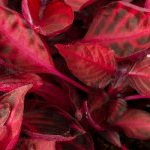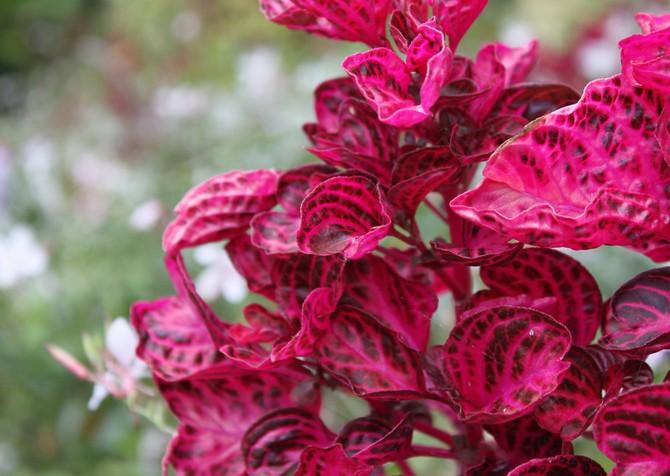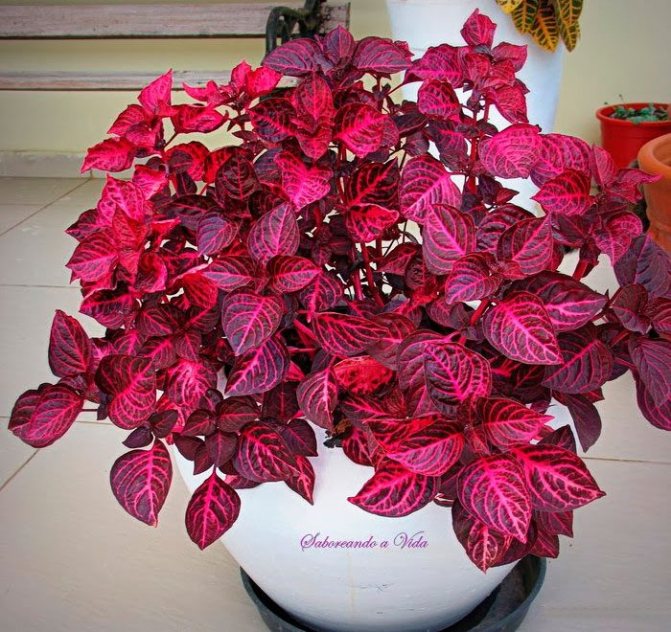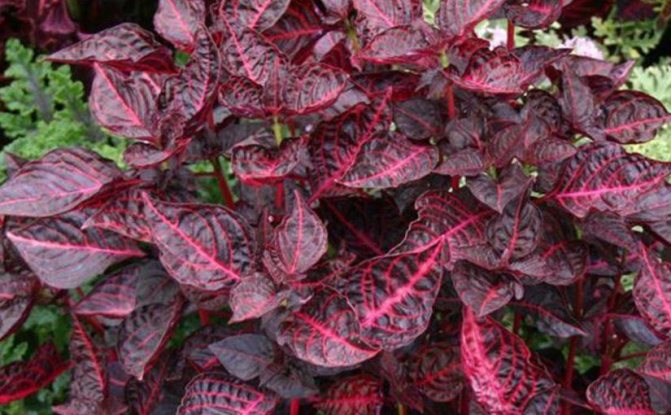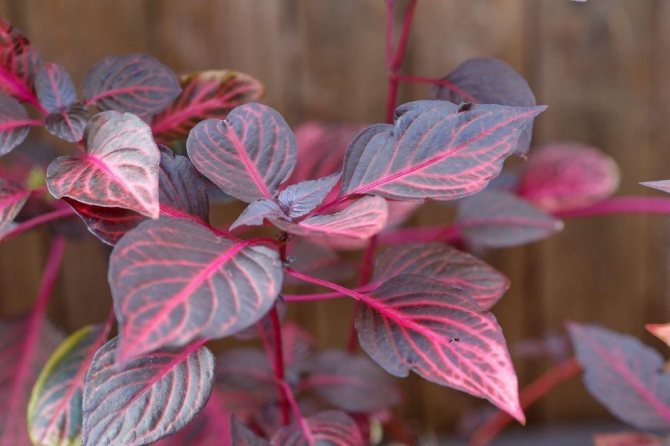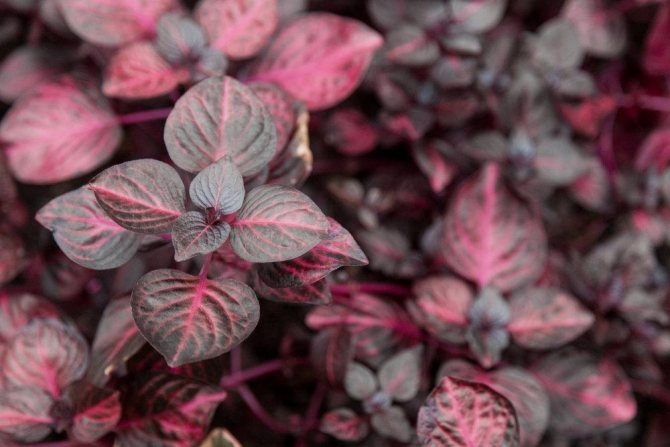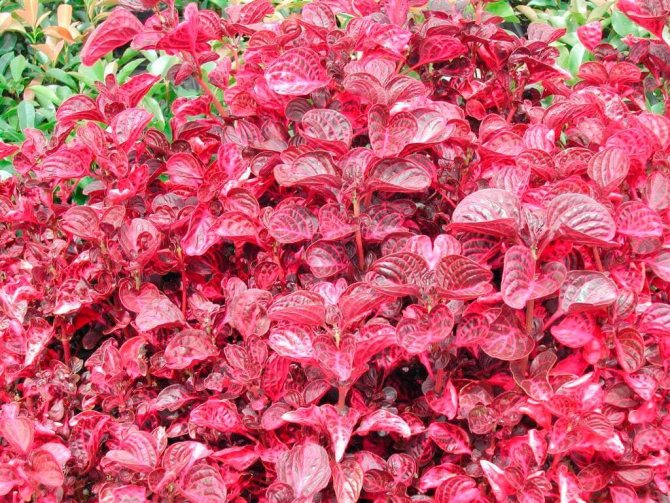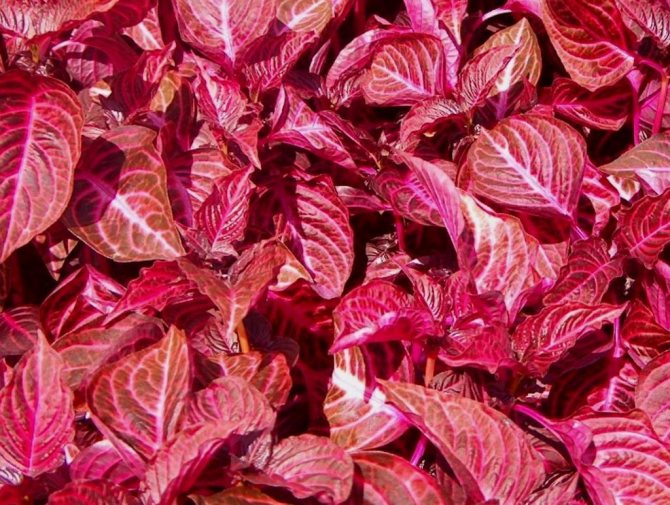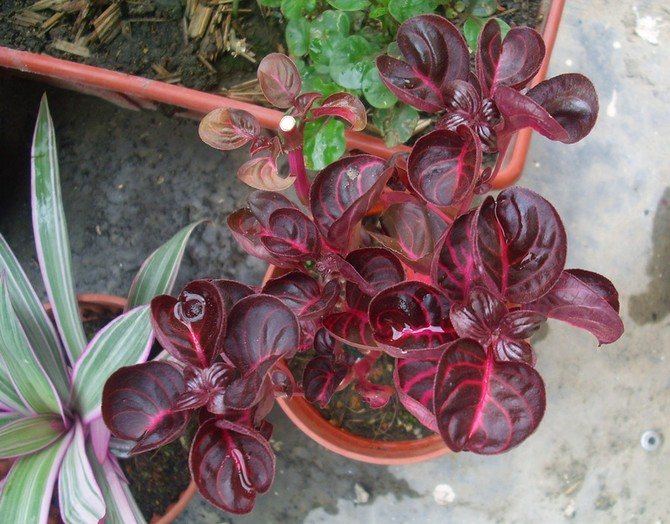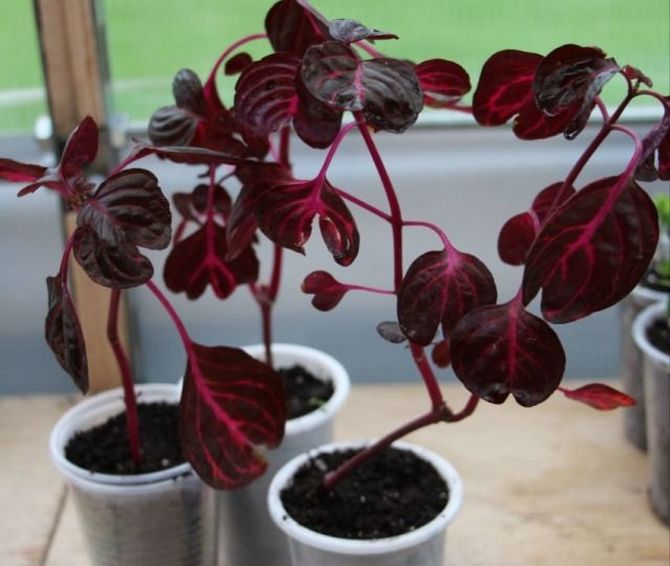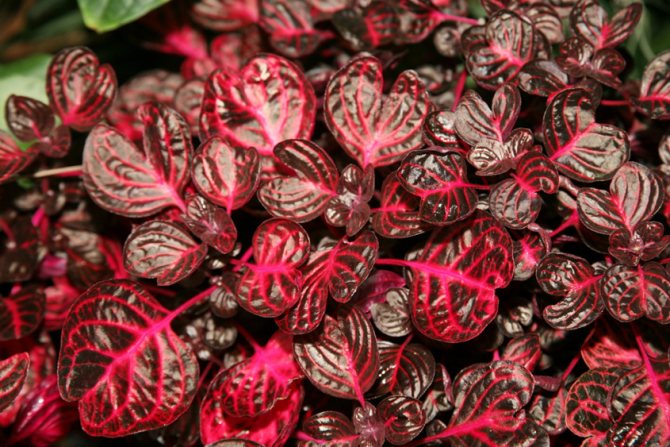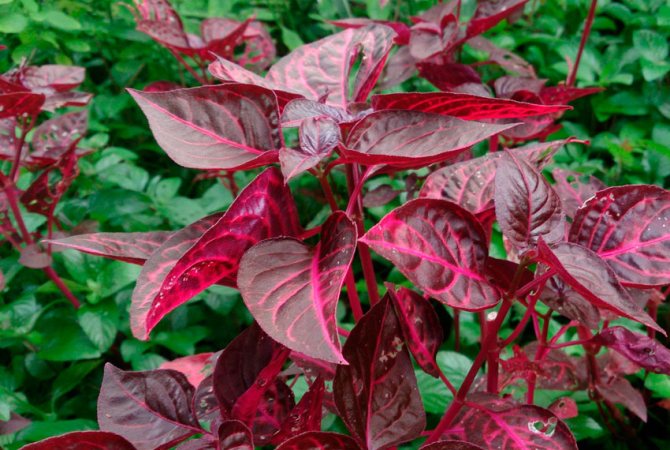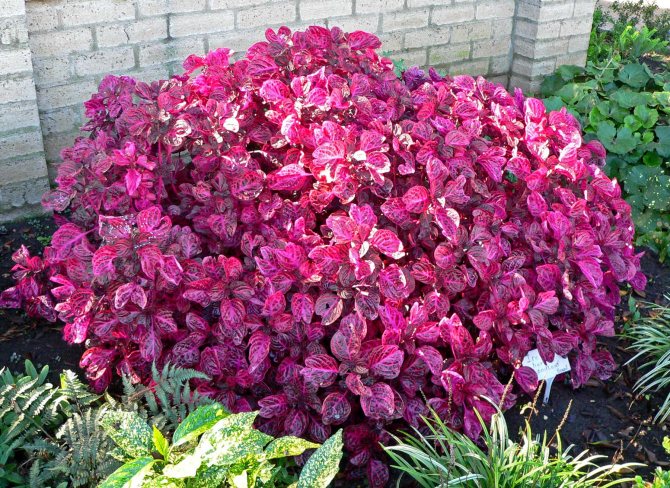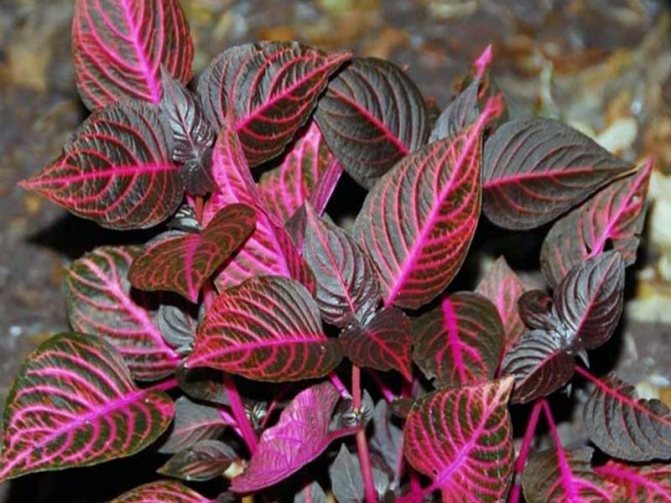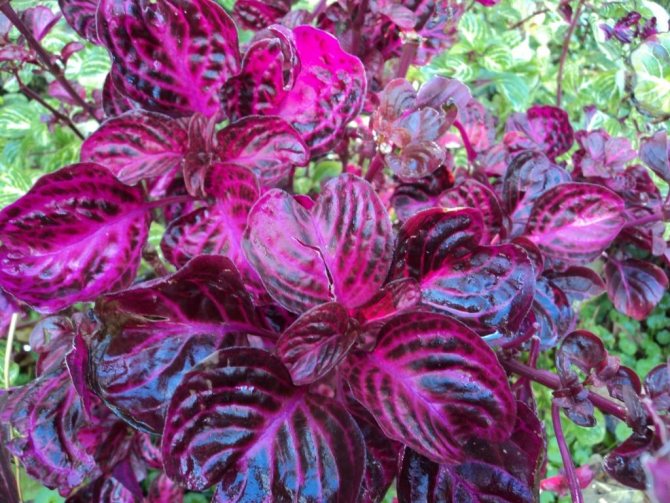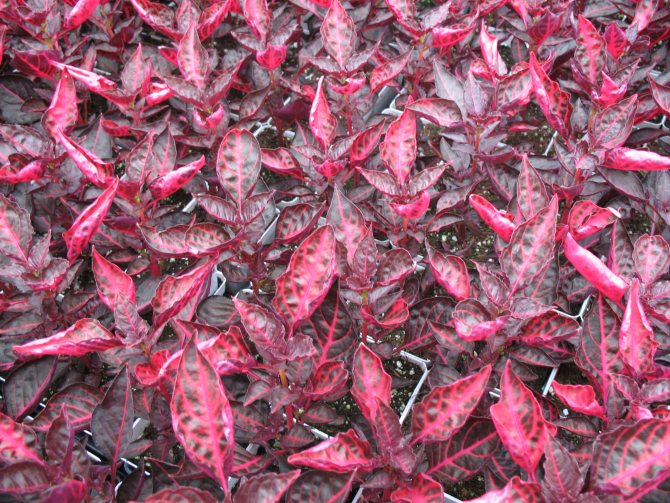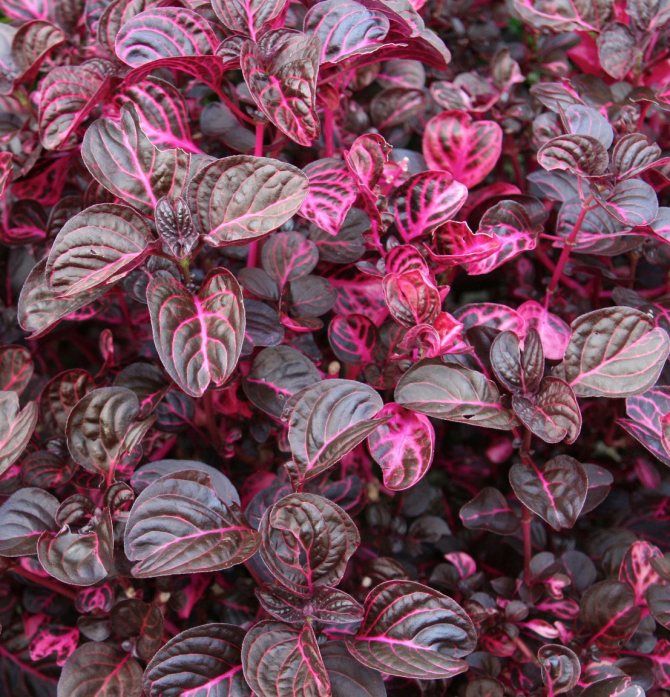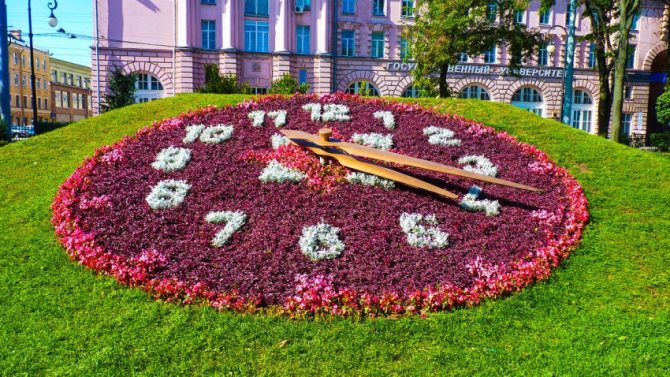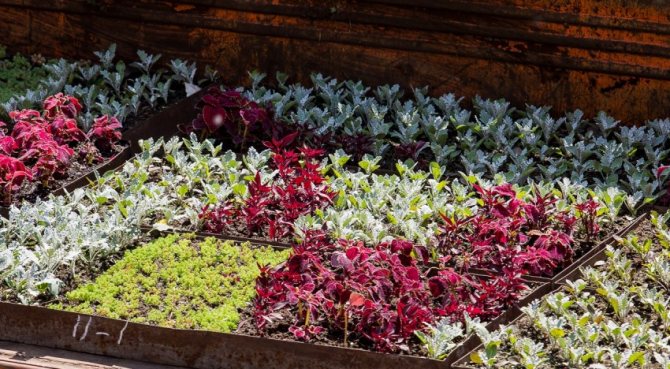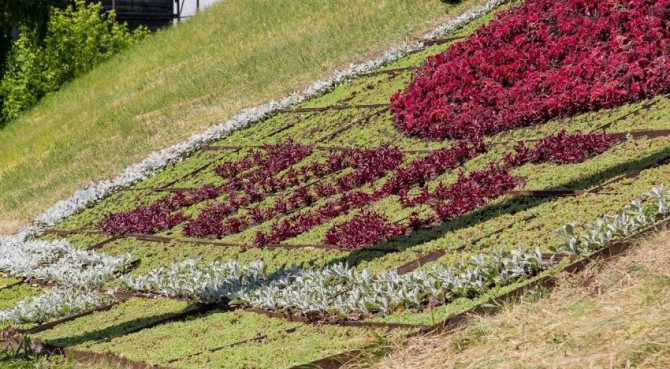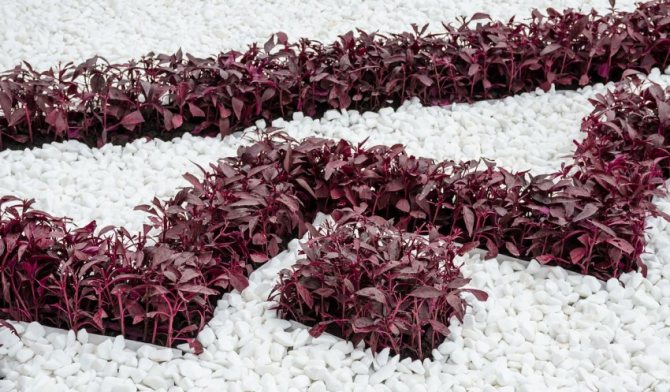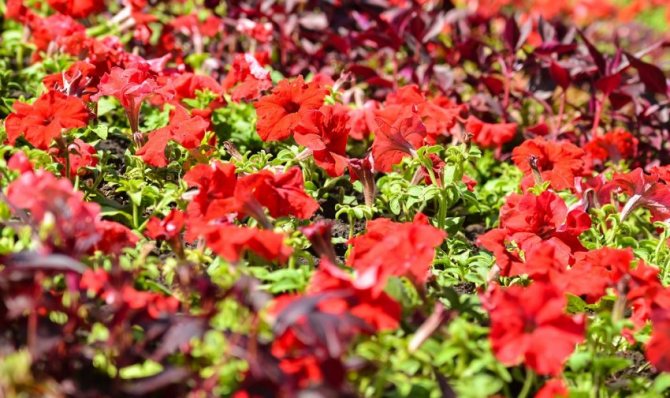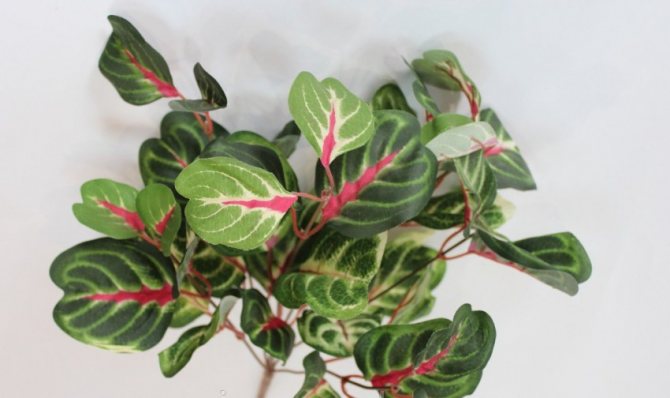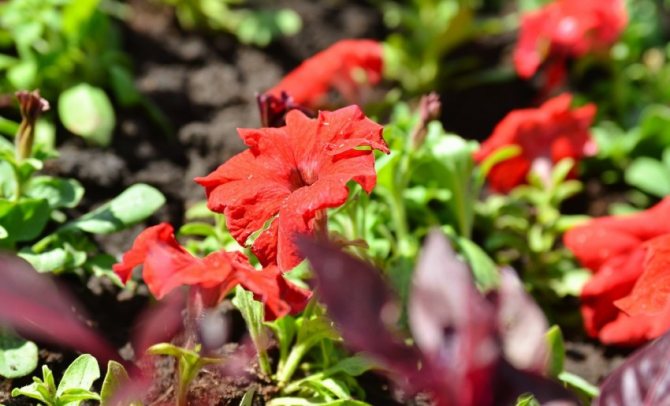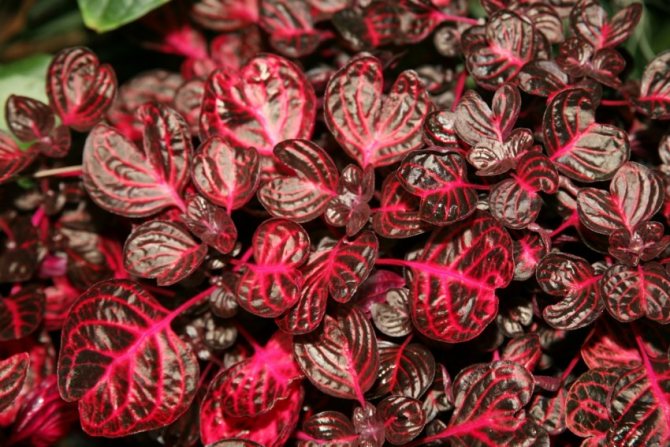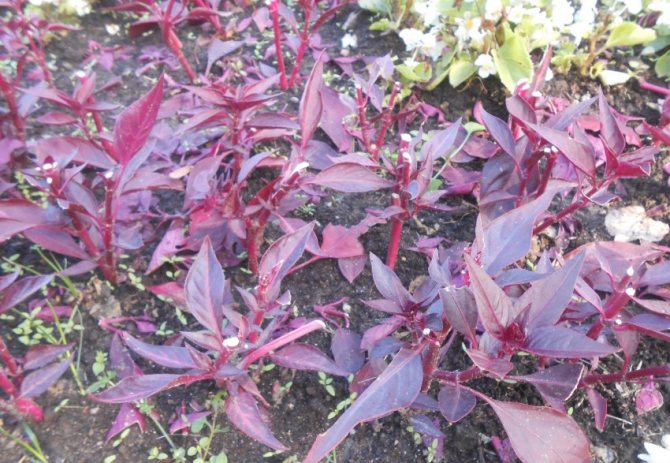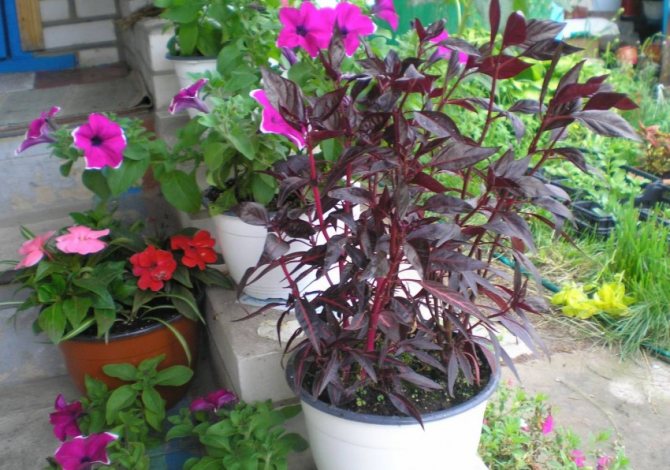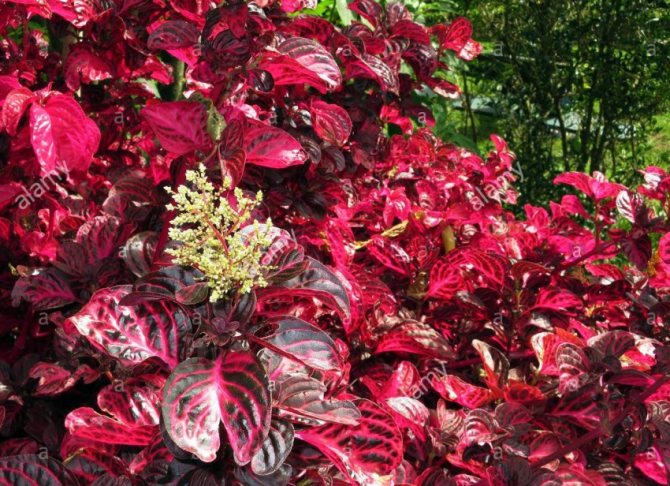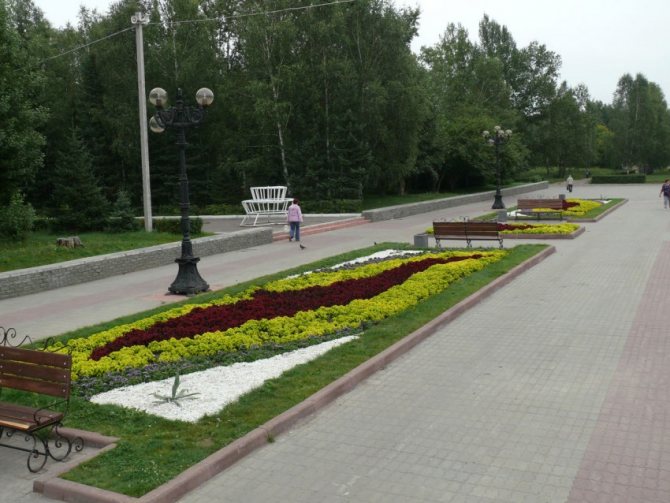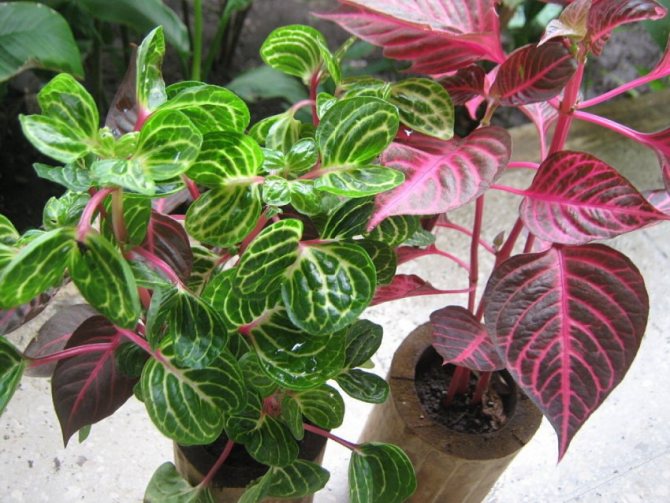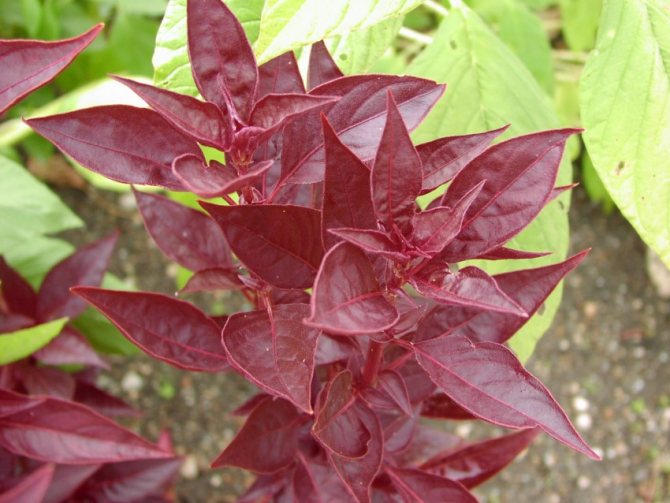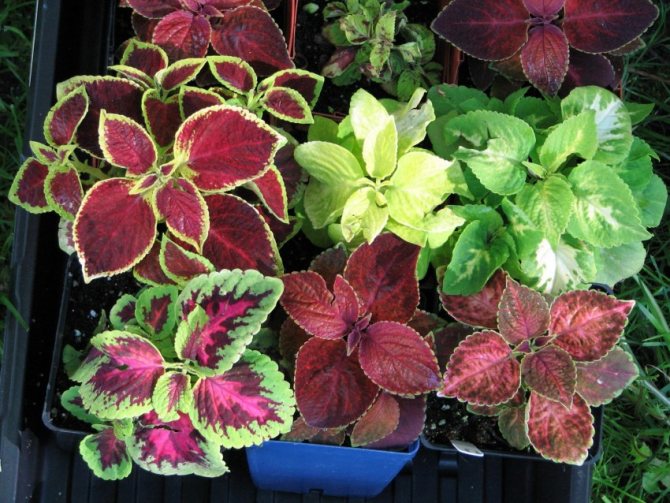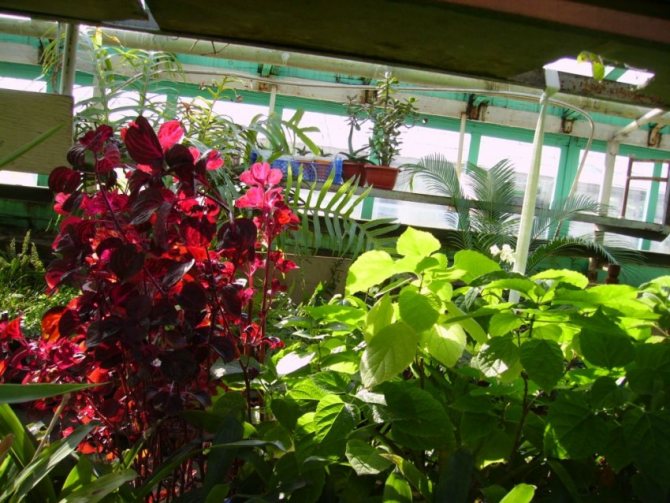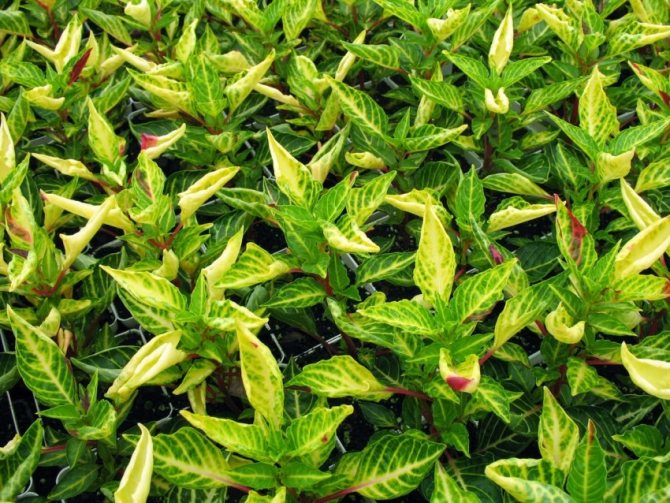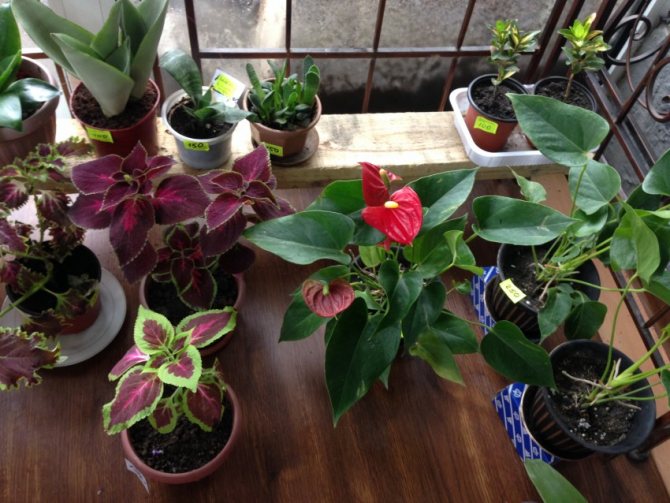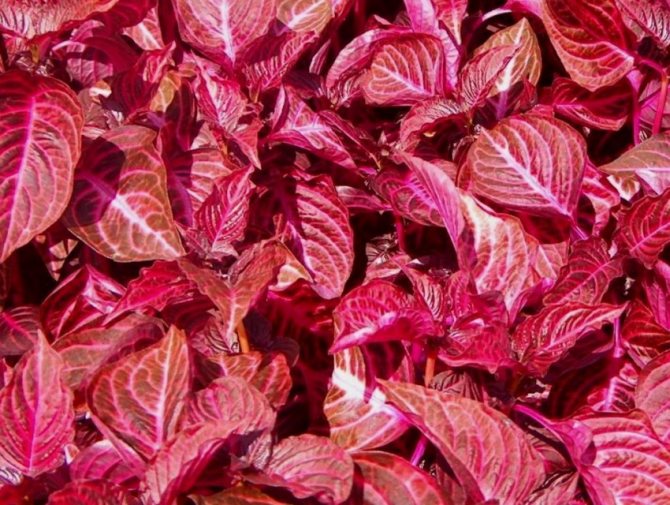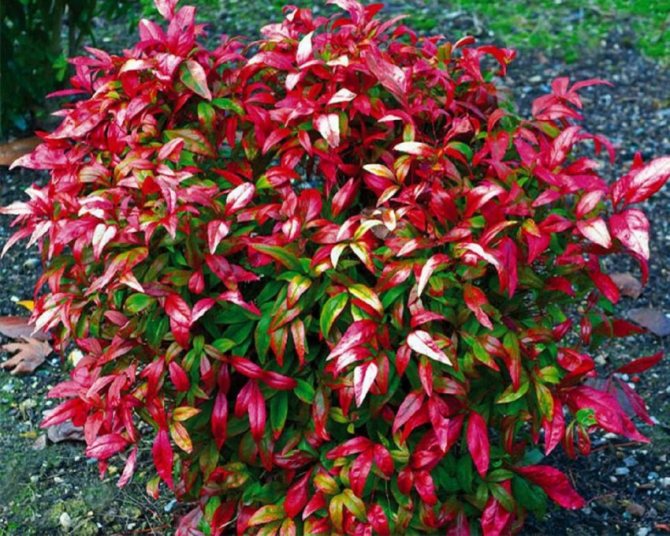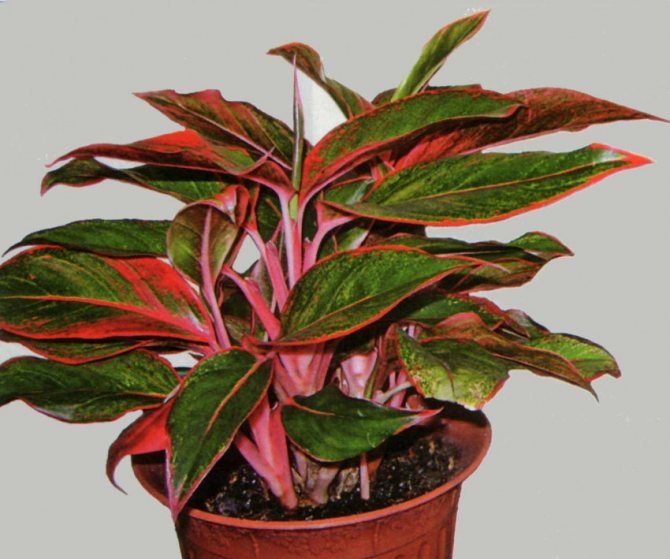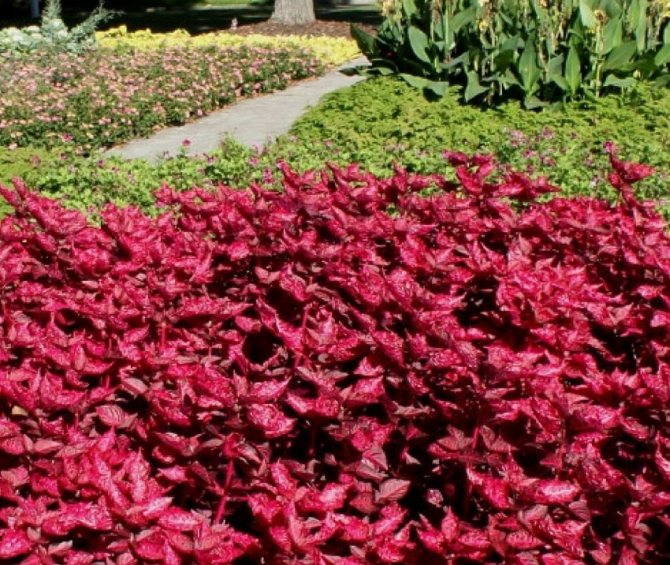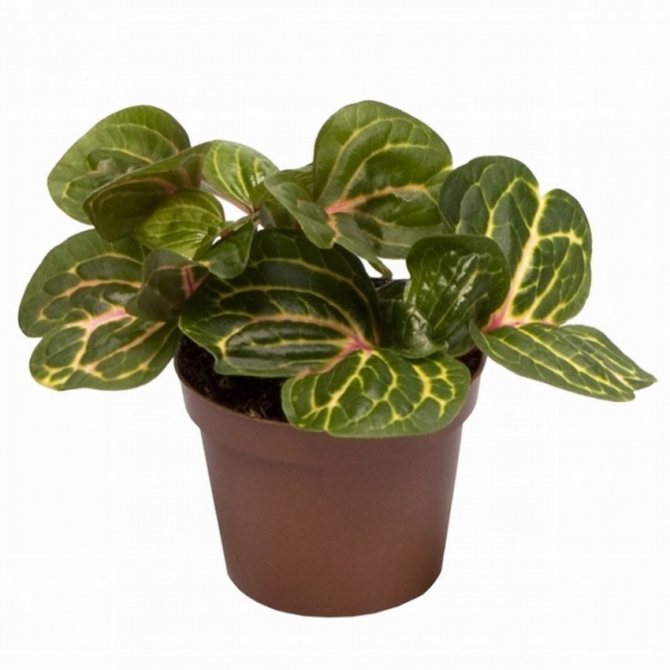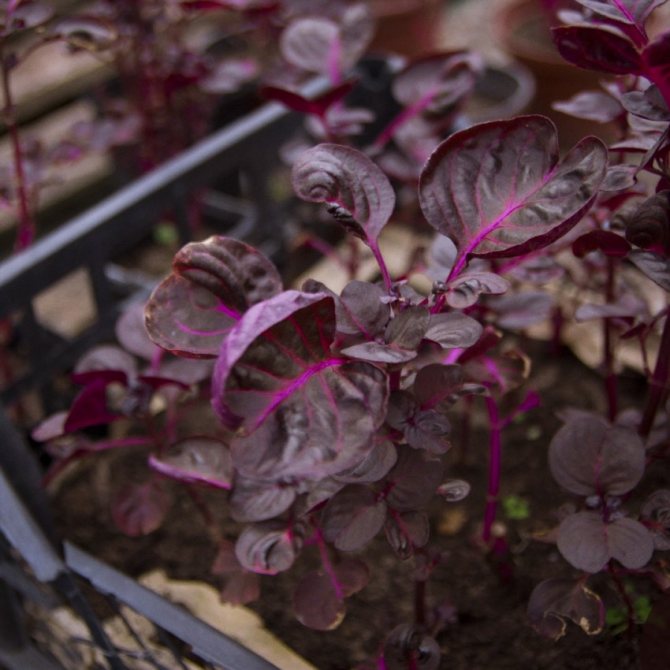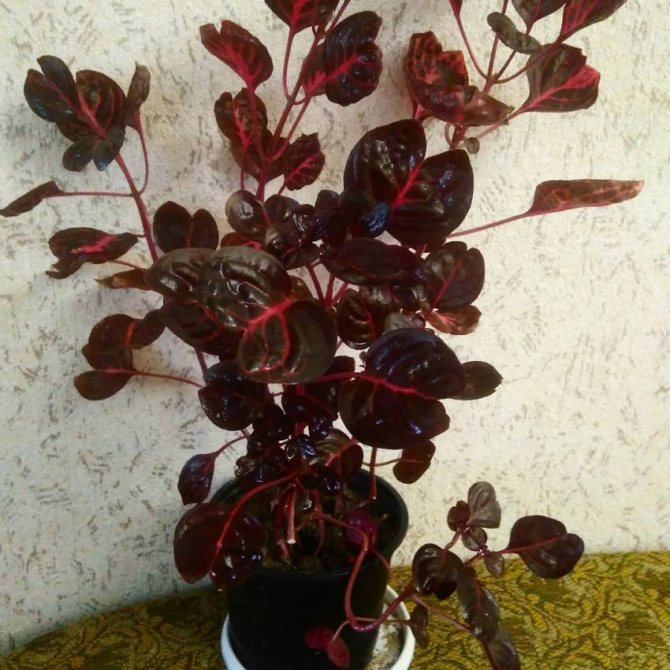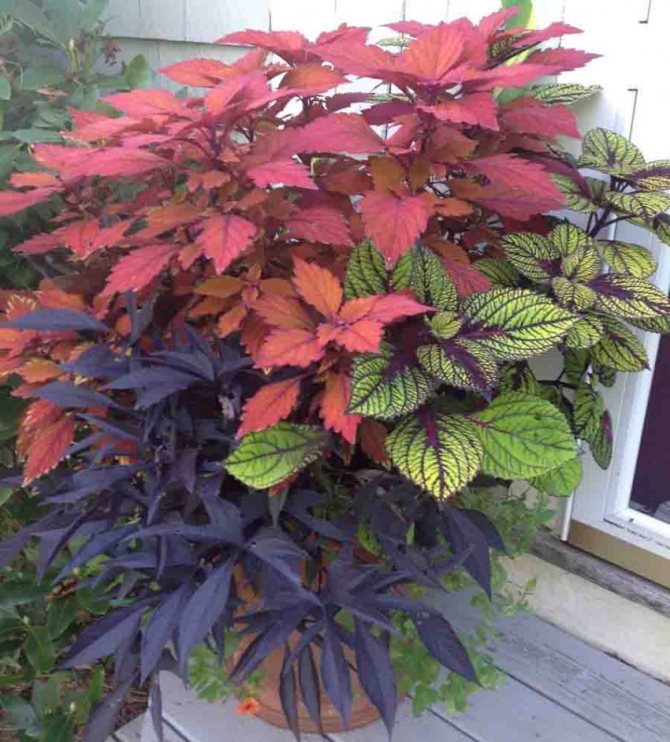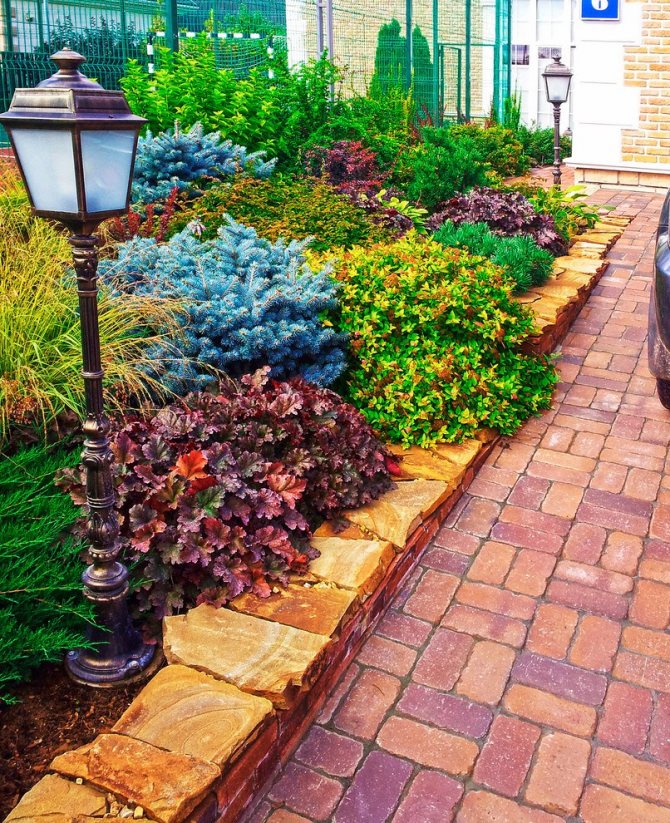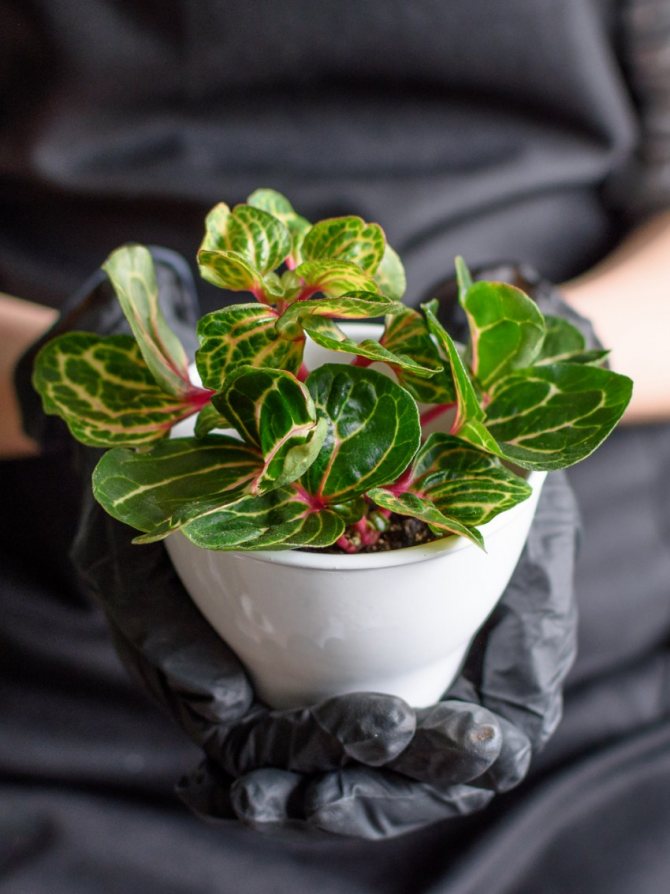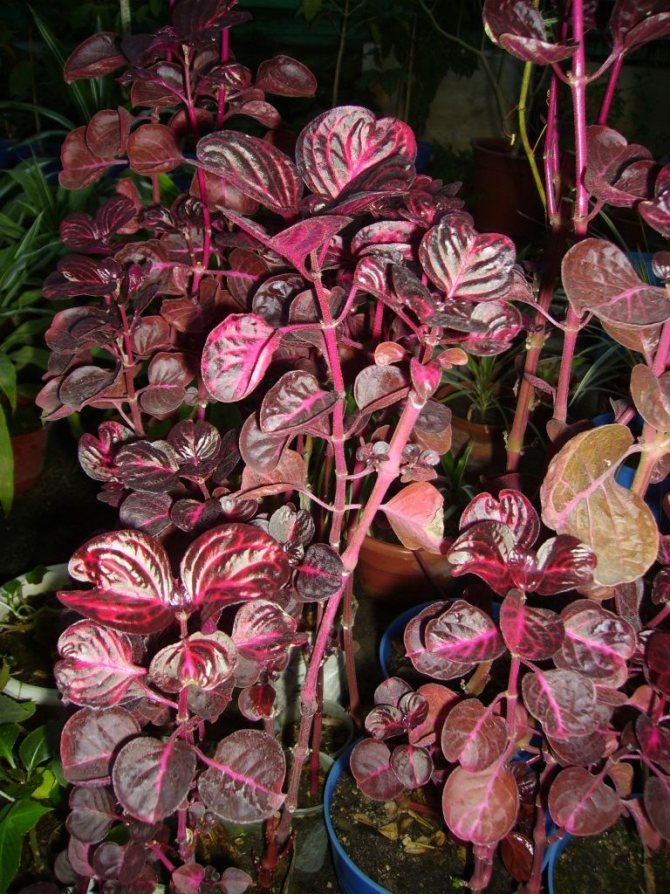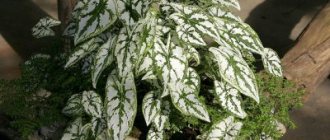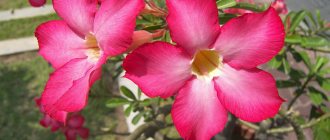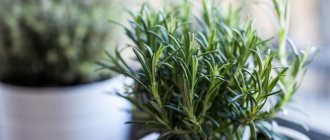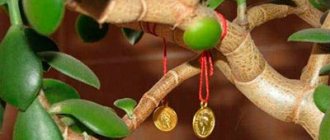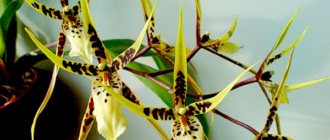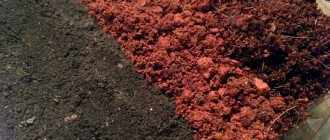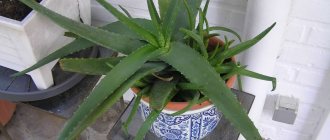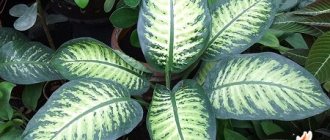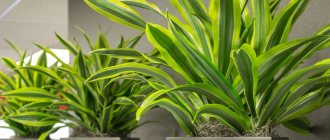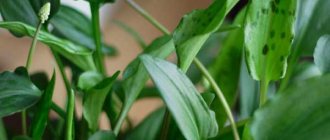Plant irezine (Iresine) is directly related to the amaranth family. This genus unites 80 species of various plants. In nature, they can be found in Australia, America, as well as on islands such as the Antilles and Galapagos.
Irezine is represented by shrubs, herbaceous plants and trees that have climbing branches. Opposite leaflets are rounded or elliptical, less often lanceolate-widened. There are small teeth on the flat edge of the sheet. The inflorescence is capitate, outwardly similar to an ear.
Such types as irezine linden and irezine herbst are especially popular with florists. These species are valued for their decorative leaves, which have a spectacular color. Often, such a plant is used during planting work, and they are also planted on lawns along the curbs.
Care rules
Irezine belongs to unpretentious plants that do not require serious care. At the same time, it grows quickly, densely clinging to the stems with its leaves.
Water the rubber with clean, well-settled water. Its temperature should be the same as the room temperature. Water this flower abundantly in summer and spring when the topsoil in the pot is completely dry.
In the rest of the year, reduce watering at times, but do not allow the earthen coma to completely dry out. If the air temperature in the room is 15 degrees, then water the plant only occasionally.
Feed this flower once a week, alternately with mineral and organic fertilizers. The dosage of fertilizers should be in accordance with the instructions for them. In winter, feed irezine once a month with a half dose of mineral and organic fertilizers.
Diseases and pests
Irezine can be attacked by spider mites, whiteflies and aphids. A sign of spider mite damage is the appearance of a whitish cobweb.
To combat it, you need to gently wipe all the leaves with a soft sponge and soapy water.
If the infection of the plant is already strong enough, and it begins to lose leaves, it is necessary to spray it with insecticides after washing.
When a whitefly is affected, a large number of white flies appear near the plant, which begin to move actively when the leaves are shaken.
The fight against this pest is complicated by the fact that the whitefly constantly flies from one plant to another.
Destruction is carried out only by regular spraying every 4-7 days, including healthy plants.
It is very important to set up special fly traps.
When a flower is infected with aphids, the leaves become covered with white sticky secretions, curl and fall off.
To combat this insect, special chemicals are used.
Also perennial plants include: Alternantera, Peperomia "Lillian", Banana.
Room care
The plant has a very positive attitude towards light, including sunlight. Unless you need to gradually get used to the direct sun immediately after purchase, if it has been standing for a long time under artificial lighting. Therefore, the leaves will retain their colorfulness only on the southern windowsills.
At the same time, irezine is quite thermophilic, although it feels good in a wide temperature range - from 15 ° С to 30 ° С. Both in summer and in winter, ordinary room conditions will fully satisfy it.
Irezine is not demanding of air humidity, but at high temperatures, both in summer and, especially, in winter, it is recommended to spray the plant.
From early spring to autumn, the plant is watered abundantly. In winter, watering is brought to moderate (several times a week), but the soil should not be allowed to dry out. It is better to take soft water for irrigation.
It is fed every two weeks from March to October with fertilizers for decorative deciduous plants. From November to February, they usually feed the same fertilizer, diluted twice.
To form a compact, pretty bush, irezina needs regular pruning or at least pinching of the apical shoots. You can prune the plant at any time of the year.
The botanical description of irezine includes two important characteristics - an unpretentious perennial when grown indoors.
Wild plants - grasses and herbaceous shrubs. Some specimens have a tendency to woody stems, so they are often confused with small trees.
In countries of subtropical and tropical zones, irezine is easily cultivated as a garden perennial with decorative leafy properties. In Russia, the plant will not survive wintering, even in very warm regions. Cold resistance of irezine is low, a decrease to 10-12 degrees Celsius is permissible. Cooling the soil below 13 causes the death of the plant.
The irezine flower got its name due to its unusual flowering. It forms beautiful fluffy flowers. From the Greek language Erios - has a literal translation "fluffy". But, at home - extremely rare blooms. To get flower buds, you will need to artificially create all the climatic conditions of the natural environment, which is extremely difficult to do in an apartment.
The height of the indoor flower irezine is from 30 to 60 cm. These are compact plants. Shoots grow quickly and branch well. Already in the second year, the plant can reach 40-50 cm. In the North American tropics, irezina can reach 2 meters in height, and its shoots are prone to lignification.
Leaf plates painted in maroon color and dissected with crimson veins have decorative value. Due to its unusual appearance, the plant is often called "raspberry paradise".
The arrangement of the leaves is opposite. They are round in shape, often with a pointed or elongated tip. Depending on the species, there are plants with different colors of leaves. Basically, the tint color ranges from deep burgundy to dark red or crimson. More often, the color of the leaves depends on the amount and quality of lighting, the brighter it is, the lighter the plate.
In gardens, green irezin is often used, especially in shady corners. The leaves of the flower become emerald in color with a lack of light.
The flowering period of wild species is spring-summer. Yellow or white small flowers, covered with fluff, are collected in spike-shaped or racemose inflorescences. After flowering, a fruit box with seeds is formed, pubescent with felt.
At home, irezine can be very finicky in terms of care. Some growers do not grow an indoor flower due to its changeable nature. Despite this, it is very popular with lovers of picturesque and vibrant cultures. Flowering, as mentioned above, is difficult to achieve in an apartment, therefore, at least in order for the perennial to please with original decorative leaves, it should be properly looked after.
The optimum air temperature in the apartment during the maintenance and care of Irezine ranges from 19 to 25 degrees Celsius in the summer. Wintering for a plant occurs while maintaining 10-12 degrees. If the apartment is warm in winter, then irezine can do without a dormant period.In no case do not allow the influence of drafts and cold gusts of wind on the flower - this can cause hypothermia and the appearance of black rot in the root system.
Location and lighting. When placing irezin on windowsills, avoid, protect the flower from direct sun. The rays leave burns and reduce the decorative value of the plates. It often happens that the leaves turn pale under the influence of the bright sun. Lack of lighting is also dangerous. If you place irezine in a solid shade, then the decorativeness of the leaves decreases (they turn green) and they begin to fall off. The best option for a place for a perennial is east or west windows shaded from direct sunlight at noon.
Watering. The irezine plant is moisture-loving. It is recommended to water it frequently and abundantly. To do this, use melt water at room temperature. With a lack of moisture, leaf turgor is lost. The difference between the temperature of the water and that in the soil leads to the appearance of rot. If you forget to water the plant for a long time, then it will fade, and it will be simply impossible to bring it back to life.
1) Protect the soil layer with a plastic bag;
2) Put the Irezine plant under the shower for 5-10 minutes, the water temperature should be no more than 28-29 degrees! Hot moisture leaves burns and the turgor of the sheet plates is lost.

Blooming forest cacti Epiphyllum will look amazing against the background of beautiful plantings of Irezine. With them, you can create combinations of striking beauty!
Some flower growers, due to the fact that they do not know how to care for neorehelia at home, often try to bypass the perennial and not purchase it in their flower collection. In fact, the plant is not very whimsical and easily takes root in absolutely any conditions. The main thing when caring for neorehelia is to observe a special temperature regime.
The range is ideal for perennials: from 22 to 26 degrees Celsius. For good growth, it is recommended to "warm up" the bottom of the soil. In the spring, the temperature of the content ranges from 20 to 27 degrees Celsius. In winter, it is recommended to keep warm at about 16 degrees. After "wintering" the plant blooms for up to 6 months in a row.
Neoregelia loves bright lighting. But, in no case should it be located in a place where direct sunlight falls, which injure the plant, leaving burns on it. In the winter season, take care of additional lighting. For neoregelia, a long daylight is recommended - about 12-14 hours of bright diffused light.
Watering a perennial is best done in moderation. Neoregelia does not like very sore soils. This can lead to rotting. Too dry soil is also not recommended, as this can cause loss of decorative appearance. Spring and summer morning watering is an excellent way to maintain a spectacular appearance.
If necessary, neoregelia needs to be transplanted into a new pot. For epiphytes, light soil compositions are chosen based on peat, moss, humus, leafy soil and pine bark. Those plants that grow roots in the ground can be planted in a mixture of humus, leafy soil and peat. Add sand for moisture permeability. When planting, make sure that 1/3 of the pot is a drainage layer of expanded clay, broken brick or pebbles.
We suggest you familiarize yourself with: Berry bushes care (August)
Fertilizers for bromeliads are used as top dressing. Nutrients are introduced once every 3-5 weeks, directly into the outlet of the leaf plates.
It is extremely important for Irezine to provide proper care. Watering, feeding, replanting and pruning should be regular and performed in accordance with all requirements.
You need to water the plant year-round by irrigating the soil. The main factor affecting the frequency is the drying out of the substrate.From March to October, the soil dries faster, so it needs to be moistened as soon as the top layer becomes dry. In frosts, watering should be moderated, but they cannot be completely stopped.
Important! The lower the air temperature in winter, the less often you need to water the plant.
The water should be at room temperature. For irezine, either water that has been settled for a day, or melted or rainwater, is suitable.
Fertilization
The introduction of fertilizing into the soil is important for the plant in all seasons. During the period of active growth from early spring to early autumn, it is necessary to fertilize irezin every week. With the onset of cold weather and before the end of winter, the frequency of top dressing should be moderated and the procedure should be carried out every month.
This bush is suitable for both mineral products and preparations on an organic basis.
Pruning
In order for the bush to have a beautiful shape, it must be pruned every year using the pinching method. You need to remove excess parts of the upper shoots. Also, at the end of the winter dormant period, it is necessary to thoroughly cut the stems of the irezine - this will help the bush to quickly enter into active spring growth.
Transfer
It is better to replant the plant at the onset of spring, although some growers advise changing the pot and the ground in any season if overgrown roots have been seen through the drainage holes.
The procedure should be performed every 2 years. If the root system does not have time to grow during this period, you can reduce the frequency of transplants to 1 time in 3 years.
The substrate for irezine is prepared from the following components:
- peat (1 part);
- sand (1 part);
- peat land (2 parts);
- sod (4 parts);
- sheet soil (4 parts).
How to overcome spider mites
Ways to combat spider mites:
- Actellic. Quickly destroys parasites. However, it is quite poisonous and is used in exceptional moments. When another remedy does not work, you can use Actellik;
- Fitoverm. It destroys not only ticks, but also other parasites. This remedy is not so poisonous, but when applied, you should still use certain protective measures;
- Neoron. The drug should be used when the mites have laid eggs. As practical activity demonstrates, one use is enough, therefore, the introduction of the funds is repeated a couple more times;
- Aktara. The chemical does not often help with the elimination of arachnids. However, gardeners speak positively of him when it comes to combating spider mites.
Popular: Air in the apartment without germs after planting Cyperus
If you notice when examining a plant that there are few insects, then it is better to use traditional methods of fighting parasites. This will be much safer for both children and animals, and for the plant itself.


Curious facts and problems in care
The plant is often used in landscaping to decorate the borders of exquisitely shaded foliage in conservatories. In addition, they are used to form flower arrangements. The irezine plant is an option for decorative use as well as landscape decoration. With proper care and proper fertilization, it will delight for a long time and luxuriantly bush for more than one season in a row.
Now read:
- Exquisite junkus (sitnik) spiral in the interior
- Variety of shapes and colors Calathea from the Marantov family
- Growing Tropical Diplomacy at Home
- The main technologies for growing peas and caring for them
About
Chief agronomist of the Limited Liability Company "Association of Peasant (Farming) Farms" Kuznetsovskaya "", Ilovlinsky District of the Volgograd Region.
Lighting, temperature
How to care for a raspberry miracle? For normal development, the flower must be well lit. In this case, direct sunlight on the leaves causes burns.
If you decide to put a pot with this flower on the windowsill on the south side of the room, then protect the plant from the sun with a screen.The duration of daylight hours for irezine should be at least 15 hours. In winter, illuminate the bush with a neon lamp.
A comfortable temperature is the limit from 16 to 25 degrees. That is, room temperature. On hot days, sometimes spray the plant with water from a spray bottle, and in winter too, if your home is too hot.
Too bright lighting and direct rays of the sun will lead to a deterioration in the decorative qualities of Irezine, causing pale color and burns in the form of brown dry spots. Lack of light also adversely affects the color of the leaves, which become faded and expressionless.
The ideal solution is the western and eastern sides, the pot is placed directly on the windowsill. If you want to put it on the south window, you should gradually accustom the plant to too bright direct lighting.
Pests. Table
| Pest | Signs | Reason for appearance | How to fight |
| Aphid | Leaves curl, sticky discharge with a sooty fungus appears on them | Excess or no fertilizer, musty air, lack of light or moisture | Treatment with insecticides is required - "Aktellik", "Akarin" or "Fufanon" |
| Whitefly | The leaves curl, turn yellow and fall off, colonies of larvae are visible on the back of the leaf plates | Musty humid air and high temperatures | Remove pests mechanically, transplant the plant with maximum soil replacement, treat it with "Confidor" or "Aktellik" |
| Spider mite | Many white dots appear on the back of the leaves, parts of the plant are braided with cobwebs | Dry air and soil | Treat irezine, flowerpot and windowsill with soapy water, treat with Apollo, Akarin or Omite insecticides |
| Scratch | Affected leaves develop a light, waxy coating and sticky discharge. | Dry soil and air, the presence of dry leaves | Treat with "Fitoverm", "Calypso" or "Aktara" |
Leaf problems. Table
| Problem | Cause | How to solve |
| The lower leaves are falling | In young specimens, this is due to a lack of light or a lack of timely pruning. | Place the plant in a well-lit place, prune elongated shoots |
| Drops leaves | Excess or, conversely, lack of moisture | Set up watering regime |
| Leaves fade, they are dominated by a green tint | Lack of lighting | Place the flowerpot closer to the window or use additional artificial lighting |
Irezine Herbst
According to official data, 20-25 species belong to the irezine genus. Many of them have become widespread as a perennial garden or indoor culture. Most of the species in tropical America are cultivated as parks. Botanical varieties have become excellent material for breeders. Next, let's look at popular varieties.
The most popular species in Russia is Iresine herbtii, known in culture for almost 100 years. In the wild, it can be found in the tropical rainforests of Brazilian forests. As an indoor flower, the Herbs species is a perennial herbaceous shrub, up to 40 cm high. Often, cultivars do not exceed the 30 cm mark. The stems are fleshy, juicy, colored red or crimson. Leaves are attached to them with long petioles to match the shoots.
1) Wallisi - juicy shoots, branching strongly, forming a beautiful spreading bush. The plant is low in height. Sheet plates of red color with a metallic sheen, most often of small size.
2) Aureoretuculata - golden irezine, differs from others in that its leaf veins are bronze or yellow. Shoots and leaves of red color.
Irezine Linden is as popular as Herbst. In the wild, the plant grows only in the humid forests of Ecuador, where it rains constantly.
In height, herbaceous indoor shrub reaches 50-60 cm. Stems are long, elastic, juicy, red.On large leaf plates of dark burgundy color. The veins cover the surface of the rounded leaf, they are thin and crimson. In length, leaf plates reach 6-7 cm with a sharp tip.
Variety of irezine plant
Irezine Lindena comes from the humid, sultry forests of Ecuador, Colombia. Small pyramidal bushes branch well. The flowers are small, invisible, white, yellow in color. It is preferable to plant irezine near walls warming up from the sun.
At temperatures below six degrees irezine lose the lower leaves. The soil for planting a plant must be loose, constantly wet, because irezine does not tolerate drying out of the roots. Irezine occasionally undergoes classic diseases. Regular pruning or pinching will promote the best bushiness.
Irezine Herbsta is a small bush, up to 50 cm in height, with leaves and shoots of a dark purple tone. The leaves are rounded with a distinctive deep notch at the top. The flowers are small. There are a number of species of this type, differing in color and shape of the leaves. For example, Irezine Herbst has amber-netted yellow leaves with wheat veins. Irezine Wallis has smaller and rougher leaves. Do not plant next to darlingtonia.
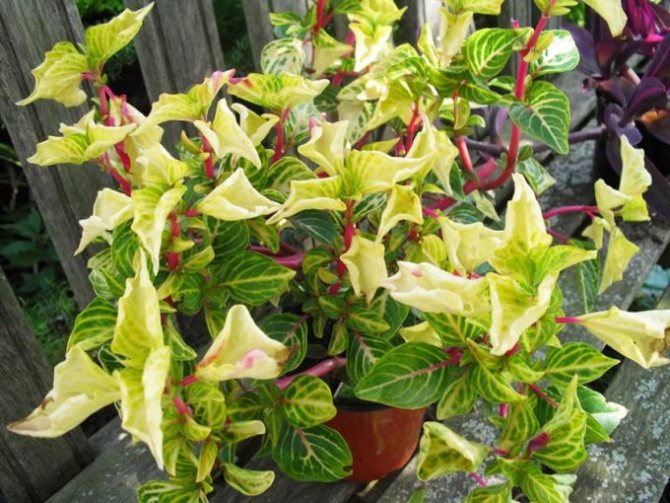

Watering
Abundant and frequent, literally every day or every other day. If you do not water for longer, the plant begins to lose turgor and withers.
Watering almost before our eyes revives Irezine. However, if you do not water it on time, the wilting process will soon enter an irreversible phase.
In winter, the amount of watering is reduced only when kept in cool conditions. Air humidity is as important as watering. Requires regular spraying and a source of moisture around the plant.
The easiest way is to place the pot in a tray with moistened stones. In order for the plant's metabolic processes to proceed normally, its leaves should be cleaned of dust and other contaminants with a damp sponge. It is useful to bathe in the shower.
They use softened, non-lime water. Pre-defended for several days, boiled or filtered.
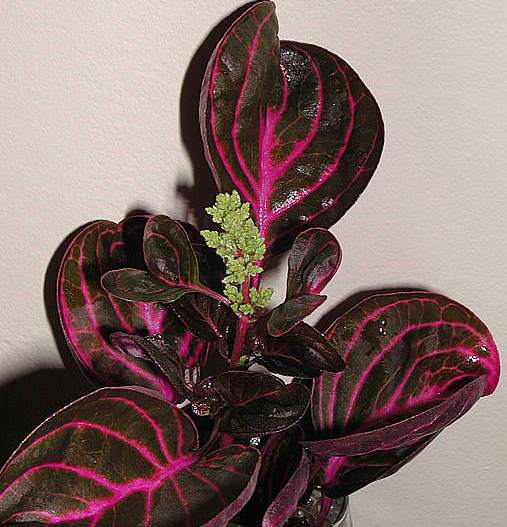

The water temperature for irrigation should be room temperature (18-22 degrees).
Irezine care
Growing irezine - temperature. A heat-loving plant that easily tolerates summer heat. Can be kept all year round at normal room temperature. The ideal range is between 18 and 27 ° C. When exposed to temperatures below 10 ° C, the plant may die.
Lighting. At least 2 to 3 hours of direct sunlight a day, preferably morning and evening. The bright color of the leaves fades with a lack of light. Shading is possible on hot summer days.
Irezine at home. Give irezina enough warmth, light, and moisture to have a beautiful, healthy plant. Pinch the tips of the young shoots so that the plant branches abundantly. Prune long stems in the spring.
Substrate. Well-drained nutrient soil, a mixture of garden soil, leaf humus, peat and coarse river sand. It is desirable that the substrate contains a sufficient amount of organic matter.
Top dressing. During active growth, feed half-strength fertilizer every two weeks.
Appointment. Place the irezine on a balcony or terrace during warmer months, where it will look great in a light-colored pot.
Flowering time. Irezine rarely bloom when kept in culture. The flowers are inconspicuous, not of particular interest, they are often removed so that the plant does not waste energy on flowering.
Air humidity. About 50% or more. Place the plant pot on a tray of damp pebbles or use a room humidifier. Spray the leaves periodically.
Soil moisture. During the growing season, water abundantly and maintain an even soil moisture. Be sure to drain excess water from the sump. In winter, reduce the frequency of watering so that the earth ball does not dry out.Use soft, cool water for watering.
Transfer. Repot in the spring when roots appear on the surface of the soil or from the drainage holes in the pot. Increase the volume of the pot gradually, as a large amount of soil can trap moisture, which will lead to rotting of the plant.
Irezine reproduction. Propagated by cuttings 8-10 cm long in spring, rooting can be done in plain water. Rooting powder can be used.
Pests and diseases. Leaves fade when there is a lack of light or nutrients in the soil. Whitefly, aphids can appear from insect pests. Decay with excess water.
Note. With age, the plant can shed the lower leaves - replace it with a new one.
Hydroponics.
You may also be interested in:
The irezine plant (Iresine) is directly related to the amaranth family. This genus unites 80 species of various plants. In nature, they can be found in Australia, America, as well as on islands such as the Antilles and Galapagos.
Irezine is represented by shrubs, herbaceous plants and trees that have climbing branches. Opposite leaflets are rounded or elliptical, less often lanceolate-widened. There are small teeth on the flat edge of the sheet. The inflorescence is capitate, outwardly similar to an ear.
Such types as irezine linden and irezine herbst are especially popular with florists. These species are valued for their decorative leaves, which have a spectacular color. Often, such a plant is used during planting work, and they are also planted on lawns along the curbs.
Description of Coral Begonia
- Flowering: the plant is grown as an ornamental-deciduous plant and rarely blooms in indoor culture.
- Lighting: bright light with shade in the afternoon.
- Temperature: in spring and summer - from 15 to 25 ºC, in autumn and winter - from 15 to 20 ºC, but not lower than 12 ºC.
- Watering: as the top layer of the substrate dries up: more often in spring and summer, less often in autumn and winter. At temperatures below 16 ºC, the plant is symbolically watered.
- Air humidity: typical for residential premises. In the heat, you can spray the plant with warm water.
- Top dressing: in spring and summer - 4 times a month with complex mineral or organic fertilizers. In the fall, feeding is gradually reduced, and in winter they are applied once every three weeks in the form of a solution in half the dosage.
- Rest period: not clearly expressed, but growth and development slow down in winter.
- Transfer: when grown in a perennial culture - once every 2-3 years.
- Substrate: 4 parts of deciduous land, 2 parts of humus soil and 1 part each of sand and peat.
- Reproduction: cuttings.
- Pests: aphids, spider mites, whiteflies.
- Diseases: as a result of violation of the conditions of maintenance and improper care, the leaves of the plant may fall off and the shoots stretch out.
We suggest that you familiarize yourself with: Organization of space in the house according to the principle of Julia Morgenstern
Botanists classify the Coral Begonia plant as an upright species, although if the stems are not tied up, they will grow horizontally. According to the description, perennial is often found under other names. In Latin, it is usually called Begonia corallina. In height, Begonia angelic wings grows up to 60 cm, although there are cases when the bush, with proper care, grew up to 1 meter.
The stems of this type of begonia are most often straight, but under the weight of the leaves they can tilt slightly. A lot of shoots are formed from one rhizome. They grow and develop rapidly. From my own experience, I can say that this is one of the fastest growing plants in my house. The stems are glabrous with clear scars that remain from the junction of the leaf petiole with the shoot.
It is due to the structure of the leaf plate that Begonia Coral is called "angel wings". The leaves are very large and colorful.The surface of the plate is matte, green, and may be patterned (most often spotted). Spots on a sheet of a silvery shade. The plate itself is very dense and cut with deep veins. The edging is not even, it creates the shape of an angelic wing.
Leaf blades have one decorative feature. In the warm season, the surface is painted dark green. Towards the end of the growing season, it becomes a rich crimson hue. On the stems, the leaves are arranged in a regular order. Plates are attached to the shoots with long fleshy petioles.
The active flowering of Coral Begonia can be observed in the midst of spring (this applies to domestic specimens). In nature, the plant blooms in early spring. In an adult plant, very large clusters with heart-like flowers are formed. The buds are collected in bunches of red or pink. The surface of the corolla is fleshy and porous to the touch.
In the wild, the plant is actively found in Central and South America. The perennial came to the European continent thanks to travelers. Botanists believe that the natural homeland for Coral Begonia is the warm rainforests of Brazil. But, despite this, the home flower is famous for its unpretentiousness and amazing ability to survive.
The cultivation of Begonia in history may have happened so quickly because the plant reproduces very easily. In order to reproduce a home specimen, you need to know how to cut it. This is the only method available in modern conditions. Only a few breeders achieve fruiting from a variety in order to obtain new unique varieties. Let's find out how to propagate Coral Begonia using cuttings.
Like many others, the plant should start the reproduction process when the perennial is in the active growing season. For coral begonias, the optimal breeding time is summer and spring. Shoots are well equipped with nutrients and have sufficient sap flow for tissue regeneration.
Decide on a nutritional formula. Coral Begonia is remarkably rooted in water without the addition of various nutrients and root-forming substances. But, this method significantly increases the period of root formation. Therefore, I recommend using a substrate.
Also, there is a possibility that if you root a perennial in cold water, without changing it periodically, the plant will grow sick. It may not be immediately visible, but ailments will manifest over time. For example, shoots may start to grow randomly - in different directions, or the leaves may form an irregular shape.
Take soil as a substrate. A composition based on nutritious peat mixed in equal amounts with river sand is suitable. The mixture, or better all separately, must be disinfected. This is especially true for sand. It is best to bake it in the oven. Cuttings are buried vertically into the nutrient mixture by no more than 2-3 cm.
In about 1-2 weeks, the cuttings of Begonia Coralova will completely root. After that, you can think about the time to start planting the plant in a permanent place.
A clay pot is suitable for this variety. But this is not a prerequisite. In my house, a perennial grows in an old plastic planter from the Soviet era and feels more than good. So I understand that the choice of a pot depends on the air temperature in the house. Earthenware is chosen only if there can be a sharp drop in the apartment.
Clay does not lose its properties and the temperature of the earth is easily maintained, which should remain constant for a tropical guest. Also, there is no chemistry in natural material, but this is generally a huge myth. It's not a fact that a good ceramic pot also contains bad chemicals. Although it has been proven that the begonia rhizome is sensitive to the composition of the soil.
Only pebbles or expanded clay can be used as drainage. Never use sand, which provokes moisture stagnation in the soil. Also, avoid chemical and synthetic compounds. Choose very light soil for planting. First, good drainage is laid, since the plant does not tolerate swampy soils.
Main types
Iresine lindenii
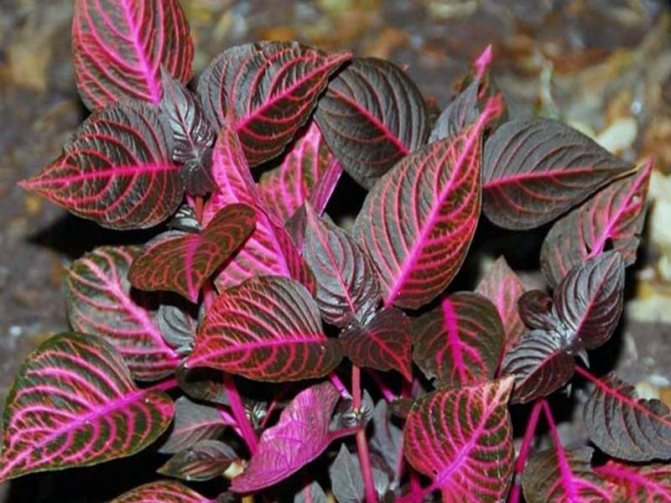

Such a herbaceous perennial plant naturally occurs in the humid forests of tropical Ecuador. The stem is dark red and slightly over 50 centimeters tall. On the surface of the dark red leaf plates, there are many thin veins with a rich crimson color. The length of such lanceolate-oval leaves reaches 6 centimeters. If you trim the plant, then it begins to branch rather strongly, while the young shoots of the leaves grow relatively quickly.
Iresine herbstii
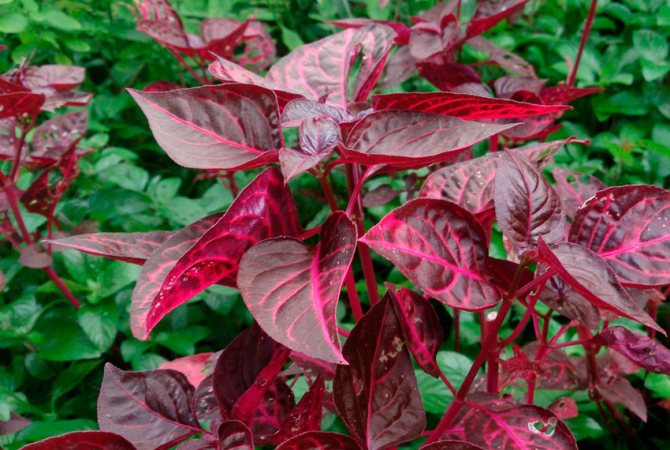

Such a perennial herb is found naturally in the rain forests of tropical Brazil. The stems are red in color and can reach a height of about 40 centimeters. Rounded leaf plates in the upper part have a heart-shaped shape. The leaves are painted in a dark purple color, and rich red veins are located on their surface. Variety "aureoreticulata" is distinguished by red shoots and leaf stalks. Red or golden veins are located on green leaf plates. The "wallisi" cultivar is a compact, rather branched plant with small leaves of a metallic red color.
> Perennial indoor flower "Irezine": photo and description
Transplant, reproduction
Irezine has a very fast growth - up to 25-30 cm per year. At the same time, she does not have a dormant period, so the plant can be transplanted all year round.
The soil mixture can be composed of humus, leaf, turf, earth and sand, if you take them in a ratio of 1: 1: 1: 0.5. Drainage is required.
Irezine
The plant propagates easily by cuttings, including those remaining from pruning. For this, parts of the shoots are suitable, the length of which is about 10 cm.
They can root both in water and in a light substrate consisting of sand and peat. At a temperature of 21 ° 25 ° C, they take root in one to two weeks. The plant also reproduces by seeds, but it is rather difficult to find them.
Of the pests, aphids and mealybugs most often attack irezin. Insecticide treatments are usually quite effective. The rest of the plant is not susceptible to diseases, subject to the basic conditions of detention.
Irezine Herbst you will transplant infrequently. Its root system grows very slowly. Usually, the flower is transplanted no more often than every three years. The presence of a drainage layer in the pot is required for this plant.
But pruning, unlike transplanting, can be done often, since the stems grow very quickly. Moreover, pruning is appropriate at any time of the year. If you wish, you can give the bush an intricate shape. Moreover, prune branches regularly.
The plant does not need an annual transplant, especially when using mineral fertilizers. As a last resort, you can replace the topsoil. The interval between transplants is usually 2-3 years.
Irezine is undemanding to the composition of the land, but it has its own preferences. It will be optimal to mix sod, leafy, humus soils and sand in equal amounts. A drainage layer of any pebbles is placed at the bottom of the pot with a layer of at least 1 cm.
Growing at home
Growing irezine from seeds is not in demand, therefore they use the propagation option by cuttings. In the spring, cuttings are cut from adult bushes and planted in the sand. When cutting, the temperature should be from 17 C. After the roots emerge, the cuttings are planted in containers. The temperature should not be below 19 C and above 21 C.
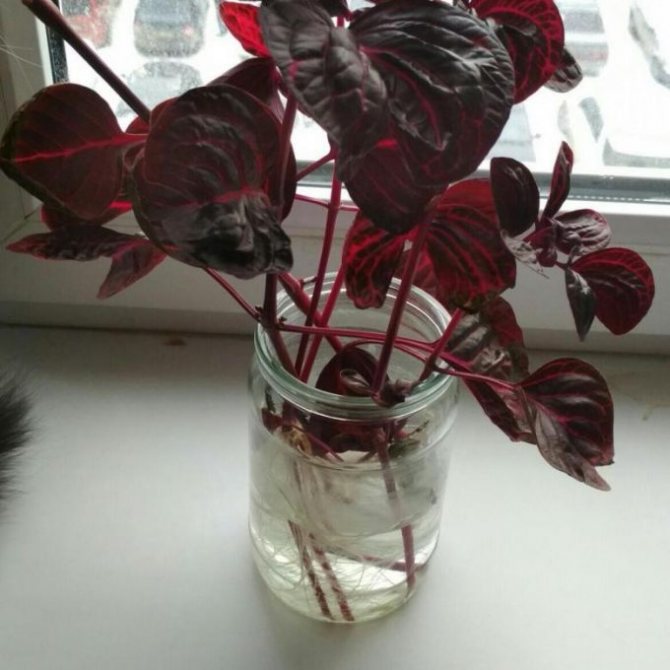

Periodically, planting must be opened, moistened and ventilated. After the sprouts appear, the glass or cover is tidied up, and the capacity is placed in a warm, lighted place. When at least three leaves open on the shoot, it is deposited in a separate container.
Caring for Coral Begonia at home
In order for Coral Begonia to please her mistress with a beautiful flowering, certain conditions and care are needed for her. A tropical guest should be comfortable at home. Despite the fact that it easily tolerates any changes and forgetfulness of its owner, this plant seems to be as whimsical as many others. From a lack of quality care, Begonia Angel Wings begins to lose its decorative properties and withers away.
We suggest that you familiarize yourself with: How to grow mushrooms at home: instructions for beginners
The most important thing in Coral Begonia's life is watering. It is divided into summer and winter. In the warm season, constant abundant water procedures are organized for the perennial. To do this, you need warm melt water (room temperature is suitable, standing for 2 days). Fleshy leaf plates lose moisture very quickly in summer, therefore, in order for the plant to always look beautiful, you need to water it often.
Winter watering is reduced to a minimum. At this time of the year, Begonia is dormant. If the house is not very hot, then "angel wings" are rarely watered. The plant categorically does not tolerate dry air, so it periodically needs to be sprayed with a small spray bottle. An overdried stream, especially from batteries, can provoke rotting of the root system.
As for the lighting, it should be intense in the summer, but not too bright. In partial shade, the perennial becomes especially decorative - the spots on the leaves are brighter and are colored in a silvery shade. In winter, you can rearrange the plant to the window. But avoid being exposed to drafts and cold airflow. Also, dry air from radiators is an unpleasant factor for growth. Without proper lighting, the shoots are strongly stretched and the shape of the bush is lost.
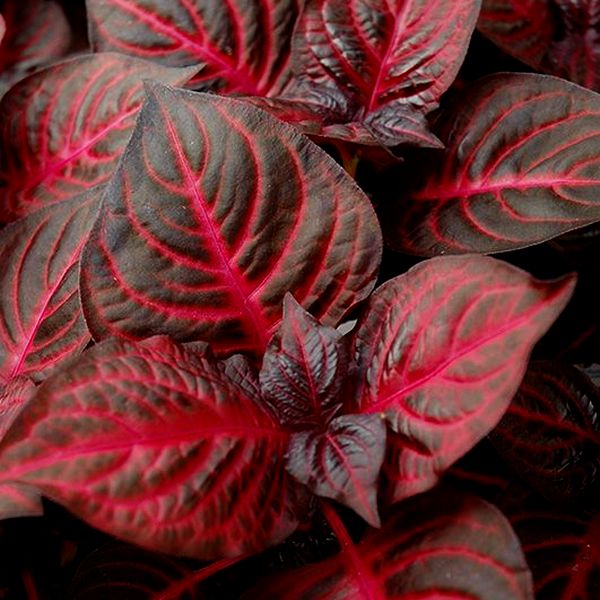

Transplanting Coral Begonia is very simple. Before carrying out it, cut off all long and elongated shoots. They need to be removed periodically. For transplanting, take a new pot of a wider diameter. It is best to transplant a perennial by transshipment. Flowers, after flowering, also need to be removed so that they do not take away strength. If you leave the buds, then this season Coral Begonia does not bloom again.
Views and photos
In nature, you can find about 80 varieties of irezine, but at home, only two have gained their popularity:
Irezine Herbsta - grows in the forests of the tropical part of Brazil, is a perennial flower with red stems. The leaves are round, separated at the top, dark purple in color with light red veins. In turn, it is divided into two subspecies - with green leaves and golden veins, as well as with burgundy leaves and a metallic sheen of the surface. Used for home cultivation. The photos below show Irezine Herbst:
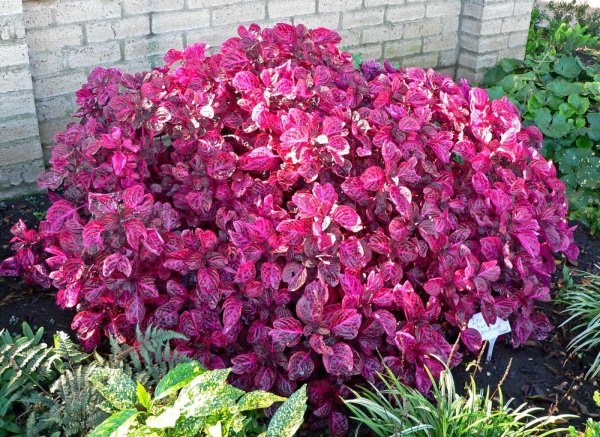

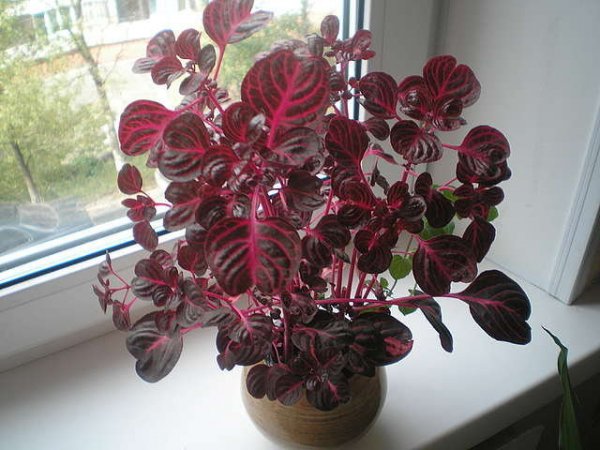

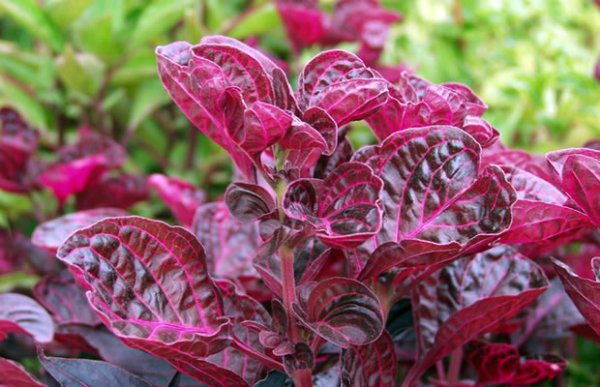

Irezine Linden - known since 1737. Its habitat is the tropical forests of Ecuador. It is a plant with a height of 50-60 cm with a stem of dark red color. The leaves of the flower are oval, up to 6 cm long, dark crimson with light crimson veins. When clipping, the plant begins to actively grow to the sides, which allows you to create an even planting in a short period. Used for growing in gardens and personal plots. You can see what Irezine Lindena looks like in the photo below:
Growing process
Under favorable conditions (humidity and heat), the cuttings form roots after 7-9 days. After waiting another week, the finished seedlings are moved into individual containers with a diameter of 6-8 cm.
The suitable temperature for young seedlings is 20-22 degrees. Watering is done often and abundantly.
To enhance growth, nitrogenous fertilizers are applied. Well-developing seedlings are pinched to form lateral shoots over 3-5 pairs of leaves.
Plant characteristic
The homeland of irezina is considered to be America, where this flower grows in tropical zones. There are only about 20-25 species of this plant of the Amaranth family, cultivated at times less.
Irezine got its name due to its unusual flowers, which, like the fruits, are covered with a small downy - from the Greek language "erios" is translated as "fluffy".
In gardens, our florists grow such a plant as an annual, if you take care of them correctly and pinch the shoots in time, you can get an interesting bright carpet from lilac or crimson leaves.
In general, the irezine flower is often found as a herb or as a small tree if grown outdoors. But, if this is a houseplant, then you can see it as a small shrub or semi-shrub, rarely reaching 50-60 cm.
The stems of the plant, depending on the species, can be very branchy and strong, they usually grow 30-40 cm and form a neat bush. On them are opposite leaves of unusual beauty, from 3 to 7 cm long.
They are usually round or heart-shaped and may be smooth around the edges or with small teeth. This flower organ is distinguished by its original appearance and is the main decorative element of the entire plant.
The color of the leaves of the irezine plant can vary from dark green to deep purple-red with bright pink veins - this can be seen in the photo below:
Iresine blooms only in its natural environment. Even in gardens, seeing her small yellow-white flowers gathering in spike-shaped capitate inflorescences is a rarity for any amateur gardener.
The flowers may have slight pubescence, they may look elegant, but still the main decorative load is borne by bright leaves. After the plant has faded, a downy fruit-box with seeds is formed.
At home, their collection and reproduction by them is a good luck for the gardener, which is very rare.
Home Neoregelia: breeding methods
There are about 40 types of neoregelia that can be grown at home. The most popular variety is Carolina. The plant is an epiphyte. Perennial varieties - most of them are botanical representatives of the flora of tropical South America. The rosette of leaves is very large. Leaves of Neoregelia Carolina, grow up to 50-60 cm.
Exotic epiphyte Gloomy Neoregelia forms a narrow funnel with long leaf plates. It always has no more than 10-12 leaves with broadly serrated sharp edges. The length of the plates is up to 60 cm. This variety is called gloomy due to the fact that the surface of the leaves is covered with dense dark hairs and small pale scales.
Popular view of Neoregelia Marble. It is a terrestrial perennial plant native to the American subtropics. Belt-shaped, broadly lanceolate leaves are collected in a very large rosette. The leaves are broadly serrate at the edges, reaching a length of 60-70 cm, it is they who form the basal rosette. On the leaf surface, there are several red spots and pale scales.
Beautiful Neoregelia is an unusual epiphyte with a wide leaf rosette. Often this variety is called Neoregelia Dressy. The leaves have a strong bend. Small sharp thorns along the edges. The lower part of the plates has a reddish-green surface. There is a red spot on the tips of the leaves. The perennial grows in height by no more than 40 cm.
Blue Neoregelia is another epiphytic species with a small dense rosette. The leaf plates are numerous, monochromatic - a dark green shade. The edge of the sheet is most often solid.Varieties with a broadly serrated edge may occur. In the lower part of the leaf plate, they are covered with small scattered white scales.
Epiphytic Little-flowered Neoregelia is a plant of stunning beauty, originally from tropical America. Long leaf plates twisted into a dense root rosette. It does not grow widely. On the edges of the leaves are rare sharp teeth, up to 1 mm long.
The offspring Neoregelia is a terrestrial houseplant that is found more often in exotic collections. The leaves form a thin, slender funnel. The peculiarity of the variety is that on the elongated shoots formed from the center of the funnel, small daughter rosettes are formed, which are suitable for further vegetative propagation. The leaf plates are green, with red spots at the tops - one for each leaf.
Epiphytic Bubbly Neoreghelia is a species with beautiful leaf blades, often grown at home. Hard, belt-shaped leaves, collected in large, but narrow rosettes in the root zone. Several rare white scales are located at the base of the leaf blades.
Epiphytic Tiger Neorehelia is another exotic epiphyte that can often be found among indoor flowers. The leaves form a dense, rounded rosette. The leaf plates are dark green, have large sharp brown thorns located along the edges. Parallel stripes of a dark brown hue emanate from the core of the rosette along the leaf surfaces.
There are two ways to get new exotic plants: daughter rosettes and seeds. The vegetative option is only suitable for those perennials that have faded. After this process, multiple daughter outlets may form. They can be left to grow on the maternal perennial, or they can be cut and rooted in a nutritious peat substrate. After the appearance of 3-4 true leaves, you can plant the plants in new places.
Container with new perennials Place the container with planting in a warm room with good lighting. Cover the plants with a transparent plastic or glass cover until roots appear. Air the planting for a few minutes every day, and as soon as it takes root, immediately remove the shelter.
Before breeding neoregelia with seeds, soak them in a manganese solution for several hours. This is necessary so that they swell and be more resistant to various diseases. Sowing epiphytes is possible only in crushed moss. It must be moist. Cover the planting with plastic and put it in a room with a temperature of 25 degrees.
Reproduction
Irezine propagates by cuttings and seeds.
For growing you will need:
- peat-sand mixture;
- polyethylene or glass;
- water for irrigation;
- growth simulator - "Kornevin", "Heteroauxin";
- capacity.
By cuttings
Reproduction of irezine using cuttings is carried out in early spring.
For grafting you need:
- in early spring (February – March), prepare cuttings 7–10 cm long with 3–4 leaves by cutting off the upper part of the shoot;
- treat them with a growth stimulant - "Kornevin" or "Heteroauxin";
- plant the cuttings in a container with a wet peat-sand mixture;
- cover with plastic or glass to create greenhouse conditions;
- place the container in a well-lit place at a temperature of +20 ° C.
After 7-10 days, the cuttings will take root, after which they need to be planted in individual flowerpots, no more than 10 cm in size, and a soil suitable for adult plants.
Expert opinion Andrey Petrovich Mokhov Graduated from the KubSAU specialty: agronomy At this time, you can begin to pinch the tops of the seedlings, forming the future crown.
Seeds
Seeds should be sown in early spring in a container filled with a mixture of peat and sand, deepened by no more than 1 cm. Cover the container with glass or plastic and keep at a temperature of + 20-22 ° C.The greenhouse must be periodically opened to ventilate and water the substrate.
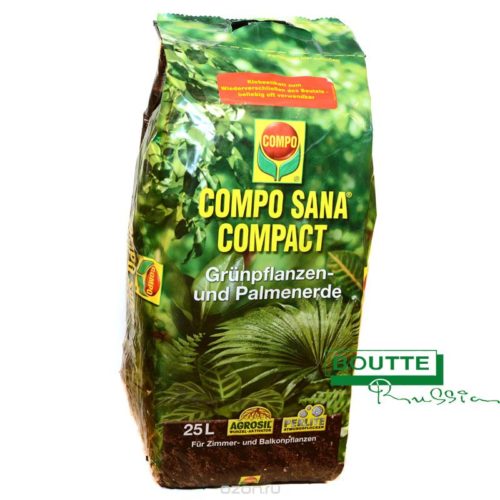

When sprouts appear, remove the glass or film, and put the container in a warm, bright place. After the appearance and disclosure of at least three leaves on the sprouts, plant them in separate pots and continue caring for an adult plant. At home, this breeding method is practically not used.
Possible problems
- With improper watering, irezine leaves fall off. This occurs both from a lack of moisture in the soil and from excess.
- Due to the lack of light, the branches become thin and strongly elongated. At the same time, the contrast of the colors of the leaves is also lost.
- If you do not prune in time, then leaves will begin to crumble from young branches.
- Irezine can infect spider mites, aphids, whiteflies and mealybugs. At home, this comes from improper care. If the bush grows in the garden and it is struck by harmful insects, then the reason for this is the weather conditions. Soap solution and subsequent insecticide treatment will help you get rid of parasites. After that, be sure to rinse the plant with warm water.
- On hot summer days, when the ambient temperature is above 28 degrees, spray the flower more often and water more abundantly. Otherwise, the brightness of the colors of the leaves will be lost.
- an excess of nitrogen reduces the intensity of the color of the leaves.
- does not like drafts.
- lack of lighting can lead to yellowing of the leaves
The leaves first lose their brightness, then fall off. This indicates a lack of nutrients in the soil. Feed the plant with mineral fertilizers, replace the topsoil.
All parts of the plant become faded, expressionless. Problems arise when there is an excessive amount of nitrogen in the soil. Top dressing should be stopped or fertilized without nitrogen.
Tags: irezine, take care
About
«Previous post
Flower diseases
If the care for irezine is not followed, several difficulties will appear:
- The flower throws off some of the leaves when not cutting;
- Leaves fall off when there is not enough light or moisture;
- If the soil is excessively moistened, the roots will rot;
- When a plant lacks the sun, it will stretch out the stems;
- The plant can infect a spider mite, and occasionally parasites such as aphids and whiteflies appear.
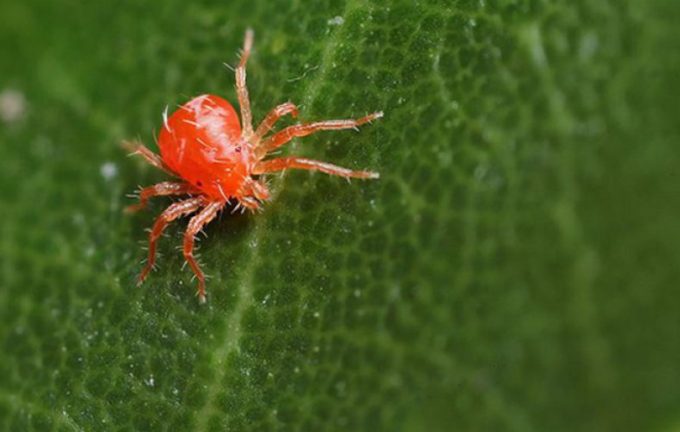

Growing conditions
Irezine in the open field prefers a well-lit area of the garden, but in spring and summer it is better to shade this culture from the midday sun. Although it is not too demanding for temperature, the optimal mode is 16-25 ° C.
A slightly acidic or neutral soil is most favorable, and moderate watering is necessary, as the earth dries up, since excess moisture can be completely destructive.
From March to September, organic and mineral supplements will be useful.
Since this ground cover came to us from an area with a warm climate, it does not tolerate winter. Therefore, in order to preserve the bushes, at the first cold weather they will have to be dug out of the ground and transplanted into a room pot or container until the next season. However, more often in temperate climates, this crop is grown as an annual. Under good conditions, each bush can grow up to 60-80 cm, but a small plant looks much prettier. To make its shape decorative, the shoots are pinched and cut off.
Danger to culture is represented by spider mites, green aphids, whiteflies and mealybugs. And appearance can tell about unhealthy growth. For example, leaf fall may indicate excessive or, conversely, insufficient watering, and too elongated, leafless stems often indicate a lack of light or not pinching. When it is too cold, the stems and leaves of irezine can become limp and wilted, and such shoots should be removed.
Irezine is propagated mainly by cuttings and sometimes by seeds.At the beginning of spring, ten-centimeter top shoots are cut and rooted in a greenhouse or pot at 16-20 ° C. Each bush is pinched over 3-4 pairs of leaves.
Transfer
If irezine is grown as an annual plant, no transplant is required. Perennials need to be transplanted every 2-3 years, when the root system will not have enough space in the flowerpot.
Also, a transplant is required 2 weeks after purchase, in case of root rot or when the plant is damaged by pests.
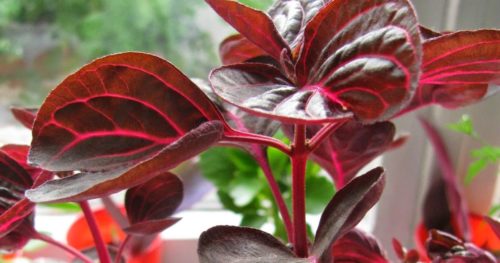

The plant has thin and delicate roots, therefore, the transplant must be carried out by the transfer method.
Transshipment:
- prepare drainage and a new pot of slightly larger volume;
- pour a layer of drainage and soil onto the bottom of the flowerpot;
- slightly crush the old flowerpot, turn it over and, holding the plant with your hands, remove it together with an earthen lump;
- place irezine in the center of the new container, keeping the old earthen lump;
- pour new soil into the flowerpot, filling the voids and slightly compact it, but do not tamp it.
Reproduction of irezine
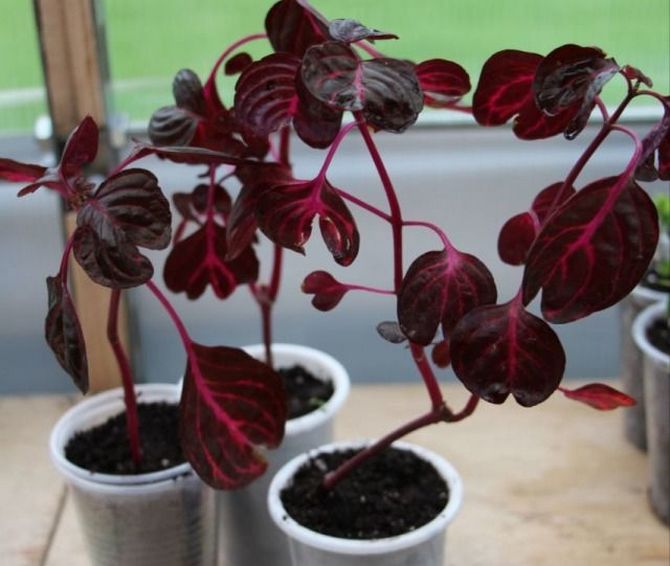

Iresine can be propagated in one of two ways - by seeds or cuttings. The second method is faster and more preferable. The tops of the cuttings are cut about 10 cm long. This is best done in February-March, when the plant wakes up from winter dormancy and prepares for active growth and development.
Further, the shoots are planted in sand at a temperature of about 20 degrees. Usually, the rooting of cuttings occurs in 9-10 days. Then, a future adult plant is formed from the cuttings. As they grow, they pinch and shape the future plant.
Irezine - description
The amaranth family includes 80 species of plants from the genus Iresine (Latin Iresine), which live throughout the continent of America and Australia, in the Galappagos and the Antilles.
Irezine - herbaceous plants, shrubs and trees with climbing branches. The leaves are arranged opposite, have an elliptical or rounded shape, sometimes - wide-lanceolate; with small teeth along the even edge of the leaf. The capitate inflorescence looks like an ear.
In indoor floriculture, they grow mainly Herbst irezin and Linden irezin, which are valued for the color of the leaves. Often used when planting ridges or to decorate lawns along the curbs.
Care features
Dollar tree photo, how it blooms, description and care at home
This is a rather undemanding plant to care for, which adapts well to low humidity in the room (especially during the heating period). But it should be borne in mind that irezina simply adores the direct rays of the sun. She needs them to preserve the rich color of the foliage. If the plant does not get light, then its leaves will become faded and lose their decorative effect. It grows very quickly, so it just needs regular pruning.
Illumination
Choose a location that is well lit. So, irezin can be put on the window sill located in the southern, southeastern, and also southwestern parts of the room. If there is little light, then the stems will become elongated, and the leaves will become faded.
How to water
Watering in the warm season should be abundant. It should be borne in mind that the substrate in the pot must be constantly slightly moistened, but not wet. Do not overflow, do not dry out the soil. In winter, watering should be reduced, and with the onset of spring, water again abundantly. However, in winter, the soil surface should not dry out between waterings.
Air humidity
It does not require high humidity. But still, from time to time you need to spray the leaves. To do this, use exclusively settled soft water.
Temperature
There are no special requirements, but it should be remembered that this is a rather thermophilic plant. In winter, it needs to be put in a warm place. So, the temperature in this place should be about 15 to 22 degrees.
Fertilizer
It is necessary to fertilize irezin during intensive growth, which is observed in the spring-summer period 1 time in 7 days. For this, mineral and organic fertilizers are used. In the cold season, this plant also needs feeding. It is necessary to apply fertilizers to the soil 1 time in 4 weeks and for this use only ½ part of the dose recommended on the package.
Transplant features
The transplant is carried out, as a rule, in the spring. To create a suitable soil mixture, it is necessary to combine turf, humus and leafy soil with sand in a ratio of 2: 2: 2: 1. In the warm season, the flower can be planted in open ground.
Pruning
Since the plant is fast growing, it needs pruning. It is carried out, as a rule, before the start of active growth in the spring. You can also pinch the twigs to form a beautiful bush, and this procedure can be carried out both in spring and in summer. The trimmed parts of the shoots can be put on cuttings.
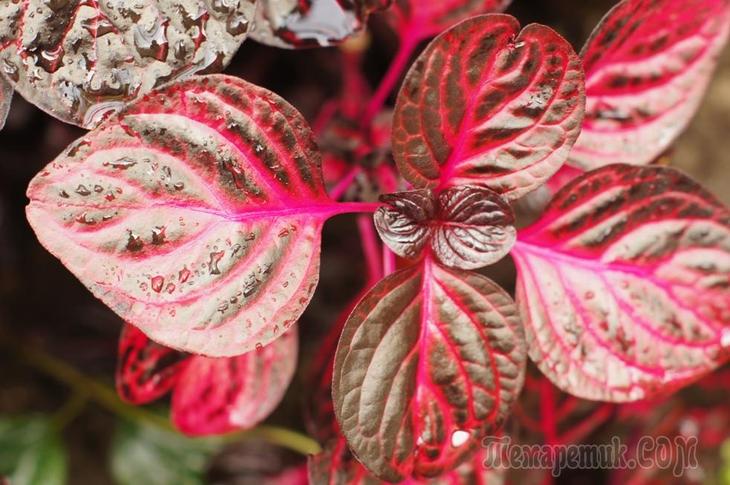

Reproduction methods
In spring, irezina can be propagated by cuttings. They should be approximately 10 centimeters long. For rooting, they are planted in a mixture of peat and sand, taken in equal proportions. They need systematic watering, as well as heat (21-14 degrees). Rooting is very fast. In just a few days, roots appear and from that moment on, the cuttings are looked after as if they were an adult plant.
Diseases and pests
Green aphids can settle on the plant. It is necessary to carry out treatment with an insecticide containing pyrethrum, which will get rid of pests.
A worm can also settle on this flower. If there is waterlogging of the soil, then the leaves, as well as the roots, may begin to rot.
This gorgeous plant is most often grown as a compact bush or as an ampelous plant. Also, in the warm season, it can decorate any flower bed. Irezina goes well with almost any plant. On flower beds and ridges, Linden's irezin is most often grown.
Plant care
Environmental conditions play a decisive role in plant life. The main ones are heat, light, air, water, food. Caring for your irezine at home is quite simple. It is necessary to take into account the main features:
- prefers bright light;
- optimal air temperature 16-25C;
- abundant watering;
- top dressing with organic or mineral fertilizers.
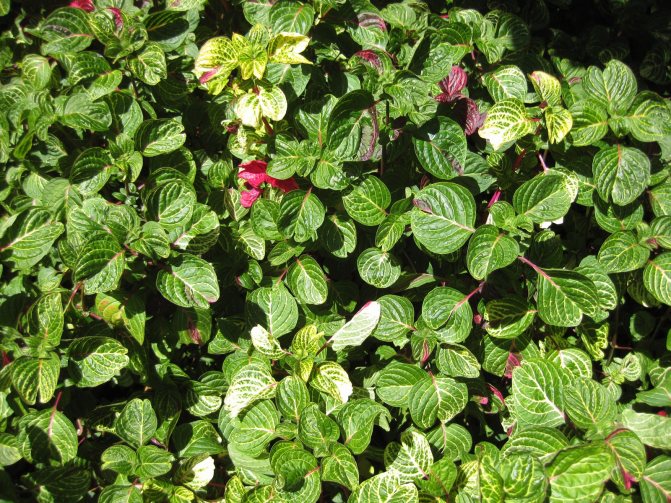

Top dressing
The irezine flower needs to be fed. The plant is fed several times a month with mineral or organic fertilizers.
Lighting
It is advisable to place Linden's irezine and Herbst irezine on the windowsills of windows facing the south. Bright diffused light will be the main condition for proper care of the irezine.
Fertilizer
Irezine needs fertilization at certain times. Florists often use ordinary yeast. They are useful for the development of the root system, cause active plant growth. Yeast is capable of producing a huge amount of healing substances: phytohormones, B vitamins, auxins, cytokinins. Also, organic or mineral fertilizers purchased in any flower shop can be used as top dressing. They are brought in once a week. In the cold season, the plant grows slowly, so fertilizers are applied less often, once a month.
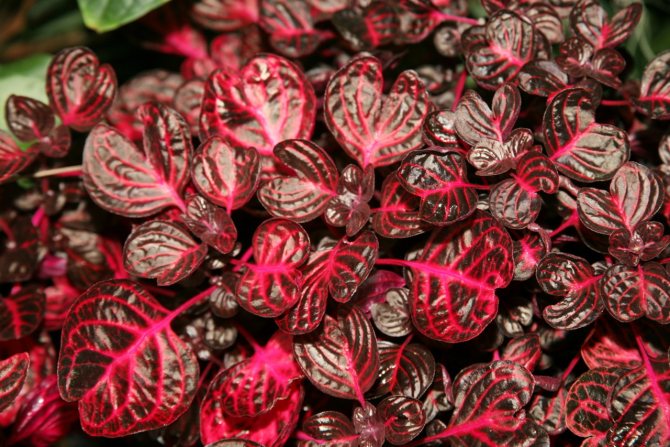

Watering
Water the plant with settled water at an air temperature. If the water is hard, then use water purification filters. Correct, or better to say, timely watering is a matter of experience. If there is any doubt about the moisture content of the soil, you just need to poke your finger on the ground or scratch it. If the soil is wet below the surface, you may not need to water it yet. Excess moisture in the soil is just as undesirable as lack of moisture.
Air humidity
Dry air does not hurt the plant too much, but it is better to either spray it, increasing the humidity, or use an indoor humidifier.
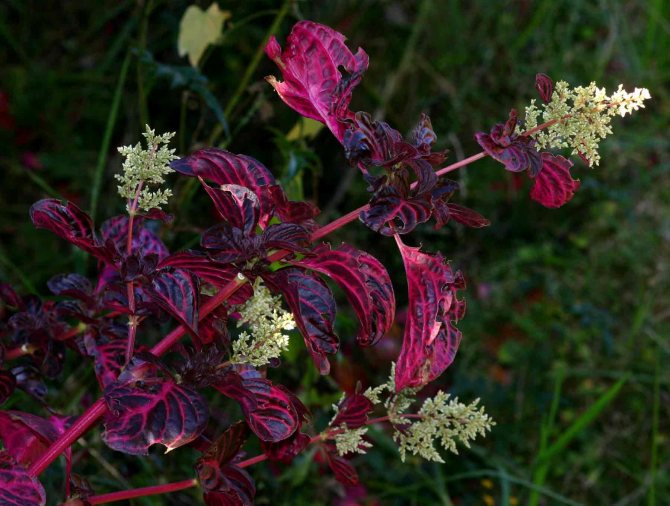

Temperature
The optimum air temperature for plant development is + 16… + 25 ° C. At temperatures below + 12 ° C, the culture will begin to rot, it may die. At air temperatures above + 25 ° C, the plant may lose leaf turgor.
Possible problems
- falling leaves;
- shoots are thin, elongated.
These difficulties can be solved by adjusting watering and lighting. It is also necessary to pinch the shoots in a timely manner.
Photos irezine
Pests and diseases
Irezin is resistant to diseases, including infectious diseases, with the exception of root rot due to a mismatch between the temperature content and watering. As for pests, their appearance is a frequent phenomenon for a given culture. It is important to notice the initial signs of an attack in order to start the fight in time and not lose the entire bush. The most common uninvited guest is aphids. Its signs are the curling of irezine leaves, the appearance of sticky mucus on them. On closer inspection, you can find the very insects, often on the underside of the leaf.
When infesting, the first measure is isolation (the same applies when pests appear on neighboring plants). For processing, you can use any insecticide of the appropriate action ("Actellik", "Fufanon", etc.). In addition to aphids, irezine is often affected by spider mites (in too dry and hot conditions), whitefly (humid and hot) and mealybugs (cold and damp).
The main prerequisites for the appearance of insects: stagnant room air, lack of light, irrigation errors, fertilization in excess of the recommended rates or their complete absence.
Varieties of irezine with a photo
There are many types of culture in the wild, biologists have described up to 800 varieties, but only two of them are suitable for breeding at home.
Irezine Linden
Brought to Europe from Ecuador. In length, the shoots can reach half a meter, but as they grow, they lie down, which is why the variety can be used as an ampelous plant. The leaves are painted in a bright blood-red color, almost crimson-black at the base, with dark burgundy veins. The leaf plates are pointed at the ends. The variety is suitable for outdoor cultivation, for example in hanging pots. Gives a very fast growth, beautifully and luxuriantly bushes. When grown outdoors, it can be used as a ground cover, quickly forms a dark crimson highly decorative coating. Such a carpet looks very impressive in large-scale landscapes, but requires tireless maintenance.
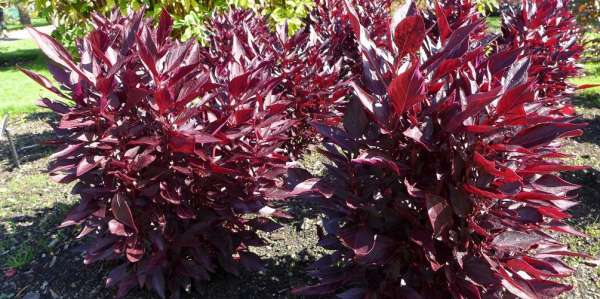

Irezine Herbst
The native land of the growth of the species is Brazil. Compared to the previous variety, it has a more compact size, the shoots extend no more than 20-40 cm. The shape of the leaves is also rounded, but at the ends the leaf plates are bipartite. On a maroon background, the venation is lighter. There are original varieties with a greenish color of leaves and yellowish or burgundy veins, as well as an unusual metallic sheen effect. This species is used exclusively as an indoor pot culture.
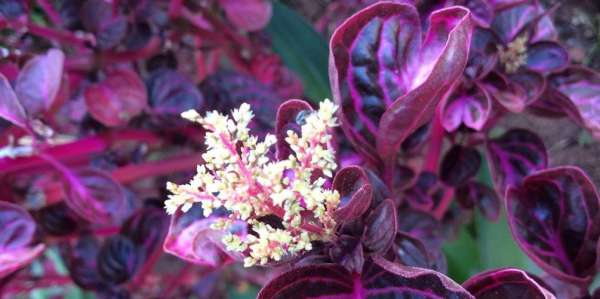

Features of the
Irezine is a genus of plants belonging to the amaranth family, in total there are about eight dozen different crops in it, which can vary in appearance, size, flowering characteristics and other individual characteristics. In its natural environment, irezine grows on several continents and islands, and the culture is also found in America.
The genus includes herbaceous plants, shrubs, and even trees; crops stand out for their branchiness and variety of leaf color. As for the shape, the foliage in crops can be round, in the shape of an ellipse, or lanceolate with an expanded part. Some plants bloom with spike-shaped inflorescences.
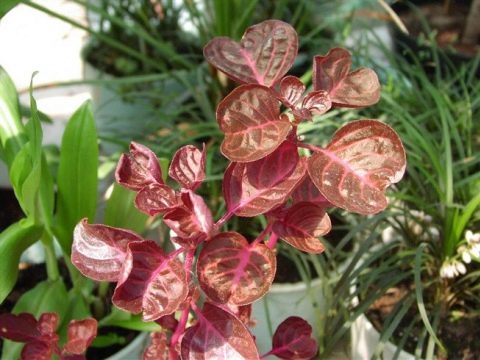

The very form of shrubs or herbaceous crops depends on the characteristics of cultivation.If the plant has a lot of free space around it, then most often it turns out to be pyramidal or spindle-shaped.
To increase the decorative qualities of irezine species grown in open ground or indoors, flower growers often artificially achieve a spherical shape of their plant by pinching the crown and side shoots. Growing irezine in the garden has a great advantage due to the low-lying foliage located in the root circle, due to which weeds are not able to germinate there.
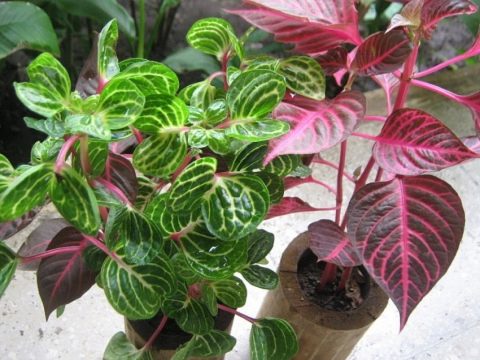

The development and size of the root system depends on the growth characteristics of the aboveground part of the culture.... Flower, shrub and other varieties of culture stand out for their lush green mass. For the most part, the predominant color is purple, and the color scheme affects all above-ground parts of the culture. Foliage in some varieties additionally has a pattern of veins on its surface. Some growers find in him some similarities with a fish skeleton, in the light of the presence of arcuate stripes.
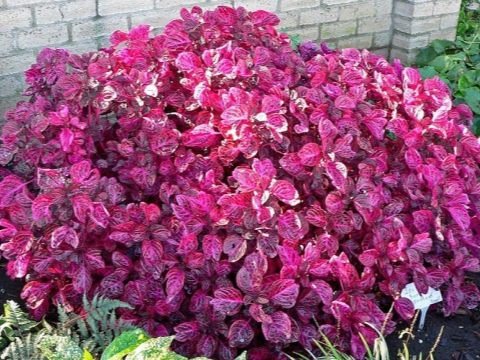

The culture blooms with small flowers that can be purple, white and even yellow. After the plant has faded, fruit pods with seeds remain in place of the inflorescences. In a closed room, irezine can bloom extremely rarely.
Among the external features of the plant, the pubescence of flowers and fruits should also be distinguished, due to which it received such a name, which in translation from Greek means "woolen". Indoor crops are an excellent natural filter for indoor air, and plants additionally saturate it with oxygen.
All types and varieties of irezine are not poisonous, so they can be safely placed on the windowsills of houses and city apartments where there are children and pets.
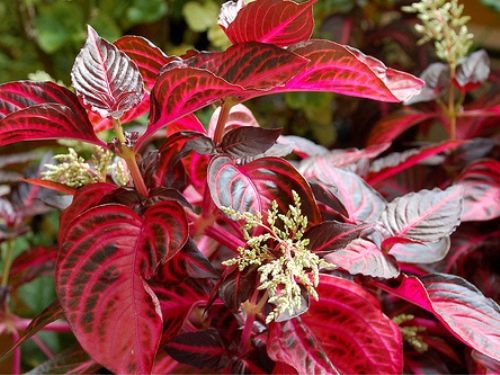

Not so long ago, the crop was mainly grown in personal plots and in greenhouses. but today flowers of this kind are actively cultivated by gardeners indoors... They create beautiful compositions by combining irezine with other crops or by planting plants in separate pots.
What kind of soil is needed?
The soil should be light, air and moisture permeable, have low or neutral acidity (pH 6-7).
You can purchase ready-made universal soil for decorative deciduous plants in the store or prepare an earth mixture yourself by mixing:
- 4 parts of sod land;
- 4 pieces of leafy land;
- 2 parts of humus;
- 1 part sand;
- 1 part peat.
Pests can be destroyed by thermally treating the soil mixture or spilling it with a manganese solution.
How to improve your site
- First of all, it is necessary to remove all construction waste from the territory, as well as various foreign objects.
- If necessary, natural plantings and bushes can be left, but if you want to radically change the appearance of the site, then they need to be cut off. It is important to consider that trees should be removed along with the root system, since after some time the reproductive properties of trees can destroy the newly created landscape.
- After all natural and obstacles have been removed, it is necessary to outline the places of future buildings (such as gazebos, benches, etc.), as well as the paths to them.
- As a rule, the paths are laid out with gravel or crushed stone, since this material perfectly absorbs moisture and prevents the growth of weeds, but paving slabs can also be used. At this stage, outbuildings and light outbuildings for recreation are also being erected.
- After that, once again, all garbage is removed from the territory and now you can proceed directly to the improvement of the landscape itself.
Do-it-yourself gardening of the site
Of course, the most convenient and simple way to plant greenery near buildings is to simply sow the entire area with lawn grass.However, there are also disadvantages here. Firstly, the site will look "naked" and uncomfortable, and secondly, it will lose its individuality.
The most acceptable and least costly way to avoid this is with ordinary flower beds or flower beds. As a rule, all varieties of special ornamental plants are designed specifically for growing them in outbuildings, and therefore easily tolerate any temperature drops and other climatic factors. Flowers, or bushy low-growing plants are perfect for decorating paths, gazebos, and you can also make all kinds of thematic drawings out of them.
Description
Irezine (other names - irezina, Iresina) is a representative of the amaranth family, it can be a herbaceous perennial plant, a shrub or subshrub, and even a tree. It grows in Australia, South and Central America. Cultivated decorative species reach 40-60 cm in height, have rounded and oblong, pointed leaves up to 6 cm in length, rich red, brown and purple shades with dark veins.
Thanks to such an unusual color, irezine has gained popularity.
Did you know? Today, there are about 450 species of carnivorous plants on the planet, which, in addition to the ability to photosynthesize, can feed on protein foods. They do not disdain insects, snails, frogs and even small lizards and rodents.
At home, it blooms extremely rarely, but even if this happens, the miniature light flowers have no decorative value. Irezine is used to create landscape compositions, as well as as a houseplant in pots or ampel structures.
Herbaceous perennial plants include such as lanceolate stellate, lychnis, acanthus, canuper herb, ornamental onion, yaskolka, tiarella, gelenium, corydalis.
Types of irezine
Irezine Linden / Iresine lindenii
The habitat of this herbaceous perennial is the rain forests of tropical Ecuador. In height, the dark red stem reaches a little more than half a meter. Dark red leaves are covered with thin veins of bright crimson color; They are oval-lanceolate, grow up to 6 cm long. After pruning the plant, the trunk begins to branch out, releasing young shoots with leaves - you can quickly get a red-raspberry blanket of leaves near the house.
Iresine Herbst / Iresine herbstii
This herbaceous perennial grows naturally in the humid forests of tropical Brazil. The shoots are red, reach a height of 40 cm. The leaves are rounded, in the upper part, shaped like hearts; dark purple with bright red veins. The aureoreticulata variety has red shoots and leaf petioles; the leaves are green, the veins are golden and red. Wallisi is distinguished by small leaves and strong bushiness with low plant height; leaves of a red-metallic color.


Iresine (Iresine) is a plant from the Amaranth family, which is short, curly herbaceous or shrub, half-shrub or tree. The place of their growth is the landscapes of North, Central and South America. It can often be found in Australia, in the Lesser and Greater Antilles.
Irezine is about 60 cm high. The leaves of the plant are round or elliptical. Irezine blooms with small flowers presented in the form of inflorescences.
Irezine is quite rare on the shelves of flower shops, so not every amateur gardener will be able to tell you how to properly care for her.
Possible problems when growing irezine
- Leaves fall at the bottom of the shoots. If the plant is adult, the process can be considered normal, however, this phenomenon often occurs due to a lack of light or a long lack of molding.
- Leaves fall along the entire length of the shoots. The reason should be sought in violation of the timing and volume of irrigation.It can be either insufficient or excessive. In the first case, yellowing of the foliage may become a harbinger of foliage, in the second - lethargy, loss of tone.
- Too elongated shoots, large distance between leaf buds. The reason lies in insufficient lighting.
- The leaves began to curl up like a tube. Infestation with harmful insects is evident. A thorough inspection and pest control measures must be taken.
General description with photo
The irezine plant (sometimes the spelling irezine is found) is a representative of the Amarantov family, known for its decorative qualities. In nature or as a result of quality care in greenhouse breeding, irezin can grow to a bush or even a tree. At home, it is a lush semi-bush that can grow more than half a meter in height. This herbaceous perennial is native to the Caribbean and South America, as well as Australia and Oceania and some other warm tropical regions.
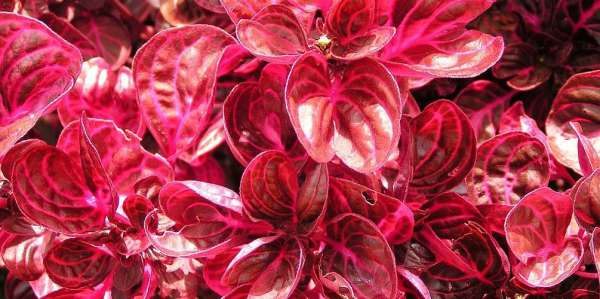

The irezine leaf plates have a rounded or oblong shape and an interesting and unusual color palette - from brown and red to dark burgundy with even darker or lighter veins. The venation of this flower is always well expressed, there is at least a slight contrast with the main color, both in the darker and in the lighter side. When grown in hanging pots, some types of crops can take an ampelous form.
It is almost impossible to achieve flowering at home, and it is not worth these efforts, since irezine flowers are inconspicuous, small, whitish in color and do not represent any decorative value.
Temperature and humidity
The comfortable temperature for irezine is + 15–25 ° C in spring and summer, and + 15–20 ° C in winter.
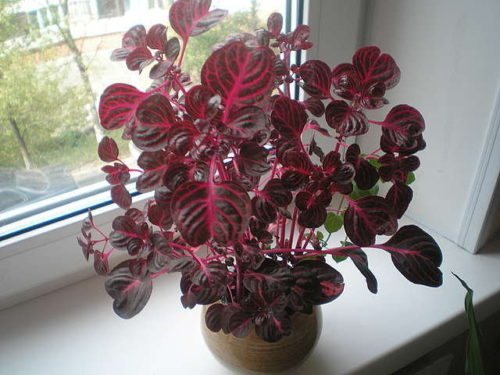

The plant reacts negatively to both a decrease and an increase in temperature: if the thermometer drops below +12 ° C, irezine sheds leaves and rots, and an increase leads to drying out of the leaves.
It tolerates dry air well, but needs to be sprayed weekly in hot weather.
Botanical description
Like beets, spinach, celosia, gomphrene and all other plants of the Amaranth or Shchirichny family (included in the order Clove), this species does not have large flowers with lush corollas of delicate colors separately placed on the stem. On the contrary, this "Apache" is all aimed at survival in the harshest natural conditions (after all, his homeland is the prairies - the steppes of America).
Many small nondescript flowers without petals (of one or both sexes) barely protrude from the prickly inflorescence-spike, the thickness of which is formed by closely adjacent bracts, and it itself looks like a sharp and wide spearhead stubbornly aimed at the sky. The ear can be multi-apical, scepter-shaped, and smaller inflorescences can grow directly from the leaf sinuses.
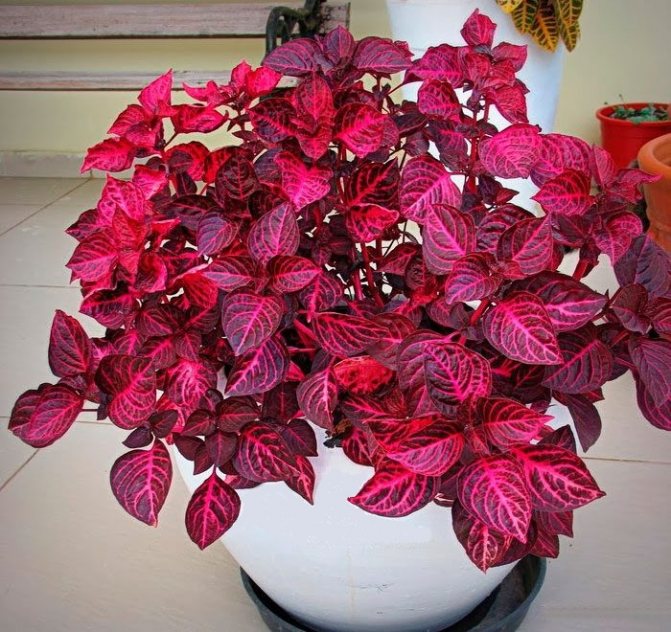

Equally "belligerent"-looking leaves (whole-edged, broadly oval, opposite, on short petioles) are also usually directed with a sharp top up or up and to the sides. Fading, they droop a little, but the general tendency of the plant "upward and in breadth" is always preserved.
The shape of irezine (like all Shchirichny ones) depends on the growing conditions. With a free landing, it is sharp or wide pyramidal or fusiform. Naturally, it is never spherical; it becomes such an exclusively compulsory order - from pinching the tops or accidentally breaking them off. It is common for a culture to try to occupy as much space around as possible, and the leaves, when planted in free soil, extend as wide as possible, which does not allow any weed to grow in the root circle.
The degree of development of the taproot depends on the power and volume of the green mass of this herbaceous bush lifted up above it.
The “warrior spirit” of a stocky, not too tall (a little more than half a meter or less) plant-“Indian” is also emphasized by its “war paint”.
She, as a rule, combines several shades of purple, and all parts of the bush have it:
- stems;
- leaves;
- inflorescences.
The drawing of leaf veins (lighter, slightly depressed) most of all resembles a fish skeleton - a spine with arcuate bones extending from it at an equal distance. In addition to the red-leaved varieties of irezine, there are also others, with a different color of leaves and their veins.

